
Green Swans: The Coming Boom in Regenerative Capitalism
by
John Elkington
Published 6 Apr 2020
Carbon pricing, meanwhile, must move from a political improbability to an integral, taken-for-granted part of our economic operating systems and markets. And fast. WICKED PROBLEM 5: SPACE JUNK HITS CRITICAL DENSITY For a long time, space exploration was very far from profitable. It was done for science, or to control a new set of commanding heights as the superpowers competed to control the planet and our future. But the wicked problems came just the same, particularly in the form of space debris. Some years back Brian Weeden, a technical advisor for the Secure World Foundation, even described space junk as a “super wicked problem.”33 Interestingly, one thing that links antibiotics to space is the fact that antibiotic resistance research has now itself gone into orbit.34 It was already known that bacteria found on the International Space Station (ISS) were more resistant, for some reason, than bacteria isolated at the Antarctic Research Station, Concordia.
…
“We’re at what we call a ‘critical density,’” says Donald Kessler, a former NASA scientist who used to run the agency’s Orbital Debris Program Office, “where there are enough large objects in space that they will collide with one another and create small debris faster than it can be removed.”35 He predicted that eventually there will be so much space junk that leaving Earth to explore deep space will become highly risky, if not impossible. That, someone might want to tell Elon Musk and Jeff Bezos, might also eventually rule out sending manned missions to Mars. Anyone who has seen the film Gravity will have some sense of where all of this could now be headed. Talk about a wicked problem with super wicked characteristics. So how do serious space people themselves view the space junk challenge? Here’s how NASA sums up the problem:36 Space debris encompasses both natural (meteoroid) and artificial (man-made) particles.
…
The collision added more than 2,000 pieces of trackable debris to the inventory of space junk. Next, while I was in that country, China carried out its 2007 antisatellite test, using a missile to destroy an old weather satellite. This single act, unlikely to be welcomed by future space travelers, added more than 2,300 trackable pieces of junk, more than 35,000 pieces larger than a thumbnail, and perhaps hundreds of thousands of pieces too small to track.37 So who has the worst space-littering record to date? Well, in 2015, it was discovered that while Russia had the most objects in space, more than 6,500 of them, it was not the biggest contributor to space junk. Instead, at the time, the United States held the title of the dirtiest country in space, even if by a whisker.
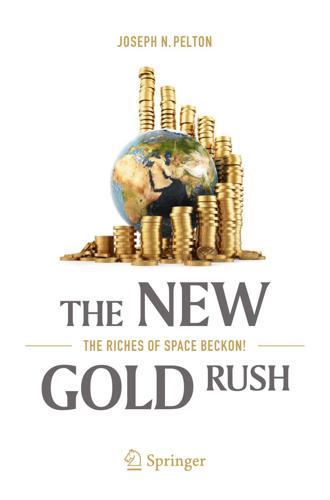
The New Gold Rush: The Riches of Space Beckon!
by
Joseph N. Pelton
Published 5 Nov 2016
There are today a number of new and developing space enterprises and activities that include space mining, the installation of solar power satellites, on-orbit servicing and retrofitting of satellites, and attempts to cope with the problem of orbital debris—including active removal, or the recycling of space junk in the skies. There are new military and defense-related capabilities in the skies, and some of these relate to the idea of planetary defense, which means the deployment of technologies in the skies to detect and monitor cosmic hazards such as asteroids, comets, and solar storms as well as systems to actually defend Earth against these perils from outer space.
…
PeltonFormer Dean, International Space University Author of MegaCrunch: Ten Survival Strategies for the 21st Century Washington, DC August 2016 Contents 1 Why This Gold Rush Is Different 2 A Space Cornucopia of Jobs, Resources and More 3 The Expanding Use of Space in Communications, Navigation, Remote Sensing and Weather Satellites 4 Commercial Space Transport, On-Orbit Servicing and Manufacturing 5 Solar Power Satellites and Space Mining 6 Space Security, Defense and Weapons 7 Protecting Earth from Space Junk, Cosmic Hazards and Climate Change 8 Space Habitats, Space Colonies and the New Space Economy 9 Governing the New Space Economy 10 Policing the Gold Rush in the Skies 11 Looking Toward a More Hopeful Global Society Appendix: Current Status of the U. S. Commercial Space Launch Competitiveness Act, Public Law 114-90, as of June 2016 Glossary of Key Terms and Phrases Index About the Author Joseph N.
…
Others are suggesting that they might change the orbit of near Earth asteroids so that they would ultimately orbit the Moon. Most agree on the need for careful prospecting to find reasonable asteroid targets before actually thinking of space mining operations. To some people asteroids are celestial bodies. But to those focused on space mining, the millions of asteroids that circle the Sun are just space junk that have no intrinsic value. In fact they see the literally millions of near Earth asteroids out there as being potentially very dangerous assault weapons that could do a great deal of damage. So why not mine them rather than let them destroy us? Countries Potentially Interested in Space Mining The fact that the four mining companies are all located in United States might suggest to some that it is only U.

Endurance: A Year in Space, a Lifetime of Discovery
by
Scott Kelly
and
Margaret Lazarus Dean
Published 14 Aug 2017
Once again, a Progress has failed to function properly, and, once again, we must worry about what that will mean for us. We are not in any immediate danger of crashing into the Earth—it would take many months for our orbit to decay to a dangerous degree—but we also use the Progress engines to move the station out of the way of space junk, so the failure could have frightening consequences. This is another strike against a piece of hardware everyone had thought of as rock solid, challenging our confidence in the Soyuz spacecraft, which are made with identical or similar components and by the same manufacturer—including the one that is meant to be my ride home.
…
“This is a red late-notice conjunction,” Jay says, “with a closest point of approach within a sphere of uncertainty.” “Roger,” I say into the microphone. Then I make sure the microphone is off before I say what I really think about this, which is, “Fuck.” A “conjunction” is a potential collision—a piece of space junk is headed our way, in this case an old Russian satellite. “Late notice” means we didn’t see it coming or that we miscalculated its trajectory, and “red” means it’s going to get dangerously close—we just don’t know how close. The “sphere of uncertainty” refers to the area it could pass through, a sphere with a radius of one mile.
…
This is the worst possible answer to my question. If the satellite were in an orbit similar to ours, the closing speed might be as low as a few hundred miles per hour—a devastating speed for a car crash, but a best-case scenario for a space crash. Instead, the space station is traveling in one direction at 17,500 miles per hour, and the space junk is traveling at the same speed in the exact opposite direction; a 35,000-mile-per-hour closing rate—twenty times faster than a bullet from a gun. If the satellite hits, the resulting destruction would be much worse than what happens in the movie Gravity. With six hours’ notice, the space station can move itself out of the way of oncoming orbital debris.
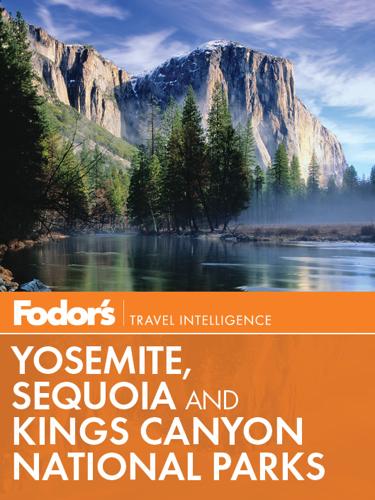
Yosemite, Sequoia & Kings Canyon
by
Fodor's
Published 17 Aug 2010
Like the moon, Venus goes through phases—check it out through a pair of binoculars. You can also spot Mars, Jupiter, Saturn, and Mercury—with or without the aid of binoculars. METEORS It’s hard to match the magic of a meteor shower, the natural fireworks display that occurs as Earth passes through a cloud of debris called meteoroids. These pieces of space junk—most the size of a pebble—hit our atmosphere at high speeds, and the intense friction produces brief but brilliant streaks of light. Single meteors are often called “shooting stars” or “falling stars.” Since our planet passes through the same patches of interstellar refuse each year, it’s easy to roughly predict when the major meteor showers will occur.
…
Each shower is named after the point in the sky where meteors appear to originate. If you’re not visiting during a shower, don’t worry—you can spot individual meteors any time of the year. SATELLITES Right now, according to NASA, there are about 3,000 operative man-made satellites (along with 6,000 pieces of space junk) orbiting the Earth—and you can catch a glimpse of one with a little practice. Satellites look like fast-moving, non-blinking points of light; the best way to spot one is to lie on your back and scan the sky for movement. Be on the lookout for satellites an hour or two before or after sunset (though you may see them at other times as well).

Infinity in the Palm of Your Hand: Fifty Wonders That Reveal an Extraordinary Universe
by
Marcus Chown
Published 22 Apr 2019
Arkhipov is not claiming that alien artifacts have been left on Earth deliberately as they were left on the moon in the film. Instead, he is asserting that they have fallen to Earth accidentally. Arkhipov points out that our space activities unavoidably pollute our solar system. Dead satellites, discarded rocket casings, and so on, end up cluttering Earth’s orbit. Such space junk is so hazardous that it caused the postponement of launches of NASA’s space shuttle for fear of a fatal collision. But, says Arkhipov, such interplanetary garbage does not stay interplanetary garbage forever. Inevitably, some manmade artifacts are ejected from the solar system and sail off towards the stars.
…
Ultra-small particles in the exhausts of space rockets will be blown away by the pressure of sunlight; space probes that explode while far from the sun will eject debris into interstellar space. But all this works both ways, says Arkhipov. Just as human activities pollute the solar system with garbage, the activities of any space-faring ETs will fill their planetary system with space junk too. And, just as our technological activities lead to the scattering of artifacts into interstellar space, theirs will also. In other words, it is inevitable that some of their junk will come our way. “For Christopher Columbus, the evidence of new lands was strange debris which had floated across the ocean,” says Arkhipov.
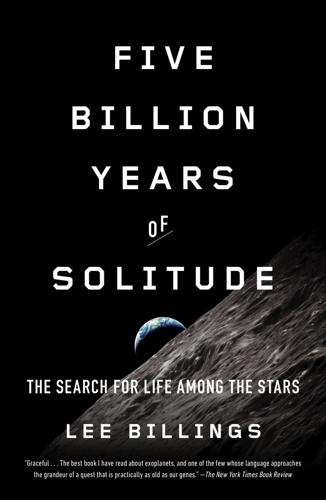
Five Billion Years of Solitude: The Search for Life Among the Stars
by
Lee Billings
Published 2 Oct 2013
The ATA would not restart operations until December, buoyed by a brief flurry of small donations. The money raised was sufficient to fund only another few months of operations. The Institute was seeking a partnership with the U.S. Air Force, which later purchased time on the ATA to monitor “space junk”—cast-off rocket stages, metal bolts, and other debris that can strike and damage spacecraft. But that funding, too, proved only temporary, and time spent surveying space junk was time sucked away from the ATA’s SETI-centric goals. Unless more wealthy patrons swooped in with heavyweight donations, the ATA had very little hope of reaching its original target of 350 dishes—and during the long recession after the 2008 turmoil in the global financial system, potential donors were proving at least as elusive as any broadcasting aliens.
…
T., 15 Pennsylvania, 124, 128, 131, 133, 138, 143, 144 coal mining in, 125 Marcellus formation in, 126–30, 137, 138, 141, 144, 160 Pennsylvania State University, 127, 149, 153 Permian Period, 132 petroleum, 125–26, 137, 160, 184 Phanerozoic Eon, 138, 144 Phobos, 100 photolysis, 156, 172 photons, 72, 89, 115–16, 156, 191, 193–94, 201, 202, 213, 216, 237–38 photosynthesis, 29, 33, 131, 140–43, 154, 169, 175, 180–82 Pioneer, 239 Planetary Resources, Inc., 258–59 planetesimals, 2 planets: extrasolar, see exoplanets formation of, in our solar system, 2–3, 31, 109, 238 Kepler’s laws of motion of, 82–84 protoplanets, 2 transits of, 53 plants, 130–32, 143 photosynthesis in, 29, 33, 131, 140–43, 154, 169, 175, 180–82 plate tectonics, 30, 105, 111, 128, 140, 144, 169, 172, 176, 179, 229 Plato, 78–80, 82 Pluto, 110, 191, 239 polarization, 115–16 POLISH, 115–17 Pollack, James, 158 Pong, Christopher, 259 Precambrian period, 139–40, 144, 154, 238 precious metals, 105–6, 111 primordial soup, 19 Proceedings of the Royal Society, 84 Project Ozma, 11, 14, 47–48 prokaryotes, 139, 140, 143, 144 Proterozoic Eon, 140–44, 171, 179 protons, 88 protoplanets, 2 Proxima Centauri, 94, 97 psychohistory, 152 pyrite, 173 Pythagoras, 78, 82 Quaternary Period, 133 Queloz, Didier, 58 radio, 42–43, 45 Radio Astronomy Laboratory, 12 Recession, Great, 13, 106–7, 165, 196 recombination, 248, 249 red beds, 131 redox reactions, 168 redwood trees, 30–31, 106, 110 Regulus, 239 Renaissance, 22, 81 Reynolds, Ray, 155–56 Ricketts, Taylor, 74–77 Rittenhouse, David, 86 Road Map for the Exploration of Neighboring Planetary Systems, A, 211–12, 214, 221 rocket equation, 186 Sagan, Carl, 16, 19, 20, 24–25, 174, 239–42, 243 San Diego Air & Space Museum, 100 Sasselov, Dimitar, 226, 249 Saturn, 28, 83, 109, 191 Saturn rockets, 151–52, 187, 188, 202, 203 Schmidt, Eric, 258 Science, 104 scientific method, 78 Seager, Sara, 243–65 children of, 251–53, 156, 160–61, 264 ExoplanetSat project of, 256–57 “Next 40 Years of Exoplanets” conference of, 225–35, 263 as Planetary Resources advisor, 258–59 TPF work of, 225–28, 232–35, 249–53, 255–58, 262 Wevrick and, 244–49, 251–56, 264 Wevrick’s illness and death and, 253–56, 264, 265 Wevrick’s marriage to, 249 SETI (search for extraterrestrial intelligence), 9–14, 38, 41 Arecibo Observatory and, 41 Drake equation and, 16–25 first modern search by, 10–11 Green Bank conference of, 15–25, 27–28, 101, 167–68, 240 lack of funding for, 10–14 Laughlin’s view of, 99 NASA and, 11–12 Project Ozma, 11, 14, 47–48 SETI Institute, 12, 43 Allen Telescope Array of, 12–14, 41, 42 shales, see black shales Simonyi, Charles, 258 Smith, Matt, 259 Snowball Earth events, 142, 174, 179 solar eclipse, 119 solar system, 19, 87 evolution of, as viewed from stars, 238–39 formation of, 1–3, 31, 139 formation of Earth in, 2, 7, 20, 139, 173 formation of planets in, 2–3, 31, 109, 238 heliocentric model of, 79–82 measuring size of, 86 shell of light surrounding, 237–38 Soviet Union, 11 nuclear weapons and, 23 Soyuz rocket, 233–34 Venera 13, 50 Space Age, 48, 50, 87, 99, 112, 151 Space Interferometry Mission (SIM), 215 space junk, 13 Space Launch System, 204 space missions, 187–99 Apollo, 1, 50, 151, 187, 202, 212, 239 Ares V, 203 Atlantis, 185–87 ATLAST, 198, 203, 230 Challenger, 3, 188–89 Columbia, 189, 196 commercial providers and, 233–34, 258–59 Constellation program, 196, 198, 203, 204, 215, 221, 223 ExoplanetSat, 256–57 Galileo, 241–42 Great Observatories, 192, 197, 209 Hubble Space Telescope, 189–93, 195, 197–99, 205–7, 209, 218–19, 226 International Space Station, 187, 189, 197, 202, 207–8, 210 James Webb Space Telescope, 193–99, 202–4, 209, 215, 216, 218, 220, 225, 262 Kepler Space Telescope, 13–14, 53–54, 56, 62, 71–73, 98, 108–9, 166, 201, 225, 229–30, 263 to Mars, 187, 188, 196, 207, 221 to Moon, see Moon, missions to New Horizons, 239 OpTIIX, 207–8, 210 Pioneer, 239–40 Saturn rockets, 151–52, 187, 188, 202, 203 shuttle program failures, 188–89 Terrestrial Planet Finders, see Terrestrial Planet Finders Tsiolkovsky and, 186–87 Voyager, see Voyager missions Space Telescope Science Institute, 198, 199, 212, 257–58 spectra, 200–202, 250 spectroscopy, spectrometers, 33–34, 51–52 in Alpha Centauri search, 94–98 CHIRON, 62 Hamilton, 58, 114 HARPS, 60–61, 63–69, 96, 98 HIRES, 59–63, 66 iodine cell calibration in, 58 radial-velocity (RV), 51, 53–58, 60, 61–64, 66, 68, 94–98, 108, 114 Spergel, David, 218–20, 249 Spitzer, Lyman, 189, 209 Spitzer Space Telescope, 192, 209 Sproul Telescope, 52 spy satellites, 188, 189, 205, 209 SRI International, 42 Stahl, Phil, 203 Stamenkovic, Vlada, 259 stars, 200–201 47 Ursae Majoris, 59 51 Pegasi, 50 61 Virginis, 55 70 Virginis, 59 Alpha Centauri, see Alpha Centauri binary systems, 18, 94 Dyson spheres for capturing energy of, 104, 105 in early cosmology, 78–80 of exoplanets, observations of, 33 formation of, 17–18, 27 GJ 667C, 65, 66 Gliese 581, 63, 68, 163 HD 83443, 60 HD 209458, 60, 228 HR 8799, 238 Kepler field, 41 laws of nature and, 155–56 M13 cluster, 39–41 measuring distances to, 86 Proxima Centauri, 94, 97 red dwarf (M-dwarf), 27, 172, 228–30, 262 spectroscopy and, see spectroscopy, spectrometers Sun-like, 18, 50, 55, 201, 228, 230, 238, 256, 257 transits of planets across, 53 Star Wars, 260–61 Stoermer, Eugene, 135 Struve, Otto, 15, 18–19, 25, 32, 47–48 sulfuric acid, 173 Sun, 31, 73, 87 birth of, 2, 31, 238 Dyson spheres for capturing energy of, 104, 105 in early cosmology, 78–82 Earth’s distance from, 83, 86 end of life on Earth caused by, 7, 31–32, 75–77, 159, 180–83 faint young Sun problem, 173–75 heliocentrism and, 79–82 orbit of, 95 shell of light surrounding, 237–38 as telescope, 35–37 Sun-like stars, 18, 50, 55, 201, 228, 230, 238, 256, 257 supernovae, 30, 88 Swarthmore College, 52 systemic, 71 Systemic Console, 54, 65 Tau Ceti, 10–11 technological civilizations, 29, 32, 104–5 emergence of, 21–22 longevity of, 22–25, 38–39, 41, 42 technological progress, 136, 183 Urey on, 101–3 and visibility of communication, 42–43 technological singularity, 43–44 tectonic plates, 30, 105, 111, 128, 140, 144, 169, 172, 176, 179, 229 telescopes, 34–36, 51, 61, 99, 170–71, 199, 201–4, 206, 208, 211–12, 223 active optics in, 204–6, 208 Allen Array, 12–14, 41, 42 ATLAST, 198, 203, 230 Automated Planet Finder, 61, 70, 114 ExoplanetSat, 256–57 Galileo’s use of, 81–82, 210 Gemini, 199–200, 203 in Great Observatories program, 192, 197, 209 Hubble, 189–93, 195, 197–99, 205–7, 209, 218–19, 226 James Webb (JWST), 193–99, 202–4, 209, 215, 216, 218, 220, 225, 262 Kasting and, 152–54 Kepler, 13–14, 53–54, 56, 62, 71–73, 98, 108–9, 166, 201, 225, 229–30, 263 mEarth Project, 228–29 Sun as, 35–37 Terrestrial Planet Finders, see Terrestrial Planet Finders see also observatories Teller, Edward, 101 temperature-pressure profile, 157–58 Terrestrial Planet Finders (TPFs), 165–67, 184, 194, 196–98, 214–35, 241, 242, 263 coronagraphic, 217–22, 224, 231, 249 interferometer concept for, 213–14, 216, 231 Seager’s work with, 225–28, 232–35, 249–53, 255–58, 262 starshade (occulter) concept for, 220–21, 225 TESS (Transiting Exoplanet Survey Satellite), 229–30 Thales, 77–79, 238 Thébault, Philippe, 97 thermodynamic disequilibrium, 168–69 Thoreau, Henry, 254 Time, 52 time, deep, 145–46 time capsule, 100–103 Todd, David Peck, 114 Toronto Sun, 74 transits, 53, 56, 84–86, 114–20, 204, 229–30, 251, 263 Traub, Wesley, 217–19, 221–25, 235 travel, interstellar, 44–45, 100–101 tropopause, 158–59 Tsiolkovsky, Konstantin, 186–87, 199, 225, 231 Turner, Edwin, 249–50 2063 A.D., 100–103 universe: Big Bang and, 89–91 evolution of, 88–89 expansion of, 87–90 inflation of, 89–92 recombination in, 248, 249 smoothness of, 89 universes, parallel, 90–91 University of California, 113 University of California, Berkeley: Miller Institute for Basic Research in Science, 48, 74 Radio Astronomy Laboratory, 12 University of California, Santa Cruz, 107–8 University of Vermont, 74–75 Uranus, 109–10 Urey, Harold, 15, 19 2063 A.D. entry of, 101–3 Utt, James B., 101 Valencia, Diana, 259 van de Kamp, Peter, 52–53 Venera 13, 50 Venus, 19, 49–50, 54, 87, 109, 154, 155, 179, 239 atmosphere of, 116, 159–60 climate of, 158–59 Galileo’s study of, 81–82 Kepler’s study of, 83–84 Laughlin’s valuation of, 73 transits of, 83–86, 114–20 water on, 28, 171–72, 179 Vogt, Steve, 55, 58–64, 66–70 Von Braun, Wernher, 1, 151, 186 Voyager missions, 35, 239–42 image of Earth from, 239–42 phonograph records on, 240 Walden (Thoreau), 254 Walden Pond, 254 Walker, James, 176–79, 181 water, 157, 170–71 on Earth, 3, 30, 158–61, 174, 177–80, 182 on Mars, 28, 179 on Venus, 28, 171–72, 179 Wevrick, Mike, 244–49, 251–56, 264 illness and death of, 253–56, 264, 265 Seager’s marriage to, 249 Whipple, Fred, 100 Whitfield, Michael, 181–82 Whitmire, Dan, 155–56 Wiktorowicz, Sloane, 115–19 Wolfe, Tom, 1 world government, 102 Wright, Orville and Wilbur, 186 Zachary, Pavl, 117–18

Yellowstone & Grand Teton
by
Fodor's
Published 16 Aug 2010
Like the moon, Venus goes through phases—check it out through a pair of binoculars. You can also spot Mars, Jupiter, Saturn, and Mercury—with or without the aid of binoculars. METEORS It’s hard to match the magic of a meteor shower, the natural fireworks display that occurs as Earth passes through a cloud of debris called meteoroids. These pieces of space junk—most the size of a pebble—hit our atmosphere at high speeds, and the intense friction produces brief but brilliant streaks of light. Single meteors are often called “shooting stars” or “falling stars.” Since our planet passes through the same patches of interstellar refuse each year, it’s easy to roughly predict when the major meteor showers will occur.
…
Each shower is named after the point in the sky where meteors appear to originate. If you’re not visiting during a shower, don’t worry—you can spot individual meteors any time of the year. SATELLITES Right now, according to NASA, there are about 3,000 operative man-made satellites (along with 6,000 pieces of space junk) orbiting the Earth—and you can catch a glimpse of one with a little practice. Satellites look like fast-moving, non-blinking points of light; the best way to spot one is to lie on your back and scan the sky for movement. Be on the lookout for satellites an hour or two before or after sunset (though you may see them at other times as well).
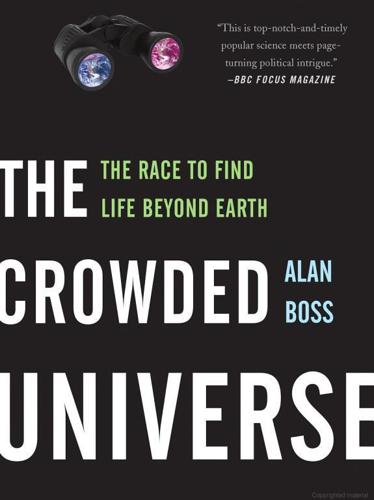
The Crowded Universe: The Search for Living Planets
by
Alan Boss
Published 3 Feb 2009
The electron microscope had also shown that the iron contained a small amount of chromium and manganese, which meant that it was in fact a 13-ounce lump of stainless steel. Mother Nature does not make stainless steel; human beings do. The Nageswarans’ meteorite had turned out to be a piece of space junk, not a meteorite. But what kind of space junk? American space satellites do not use stainless steel, but rather titanium. That meant the Russian space program was likely to be the source of the object, because the American and Russian space programs were the primary polluters of the skies (at least before the Chinese used a warhead to destroy one of their own failed weather satellites later in 2007).
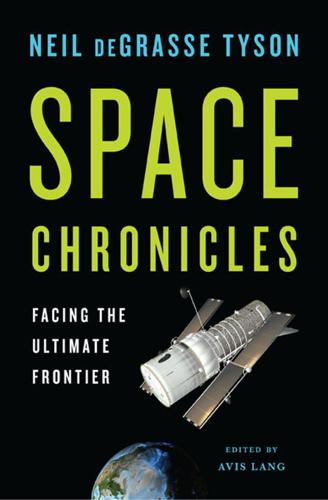
Space Chronicles: Facing the Ultimate Frontier
by
Neil Degrasse Tyson
and
Avis Lang
Published 27 Feb 2012
For two and a half years, Genesis faced the Sun and collected pristine solar matter, including atomic and molecular particles from the solar wind—revealing something of the contents of the original solar nebula from which the Sun and planets formed. Given that L4 and L5 are stable points of equilibrium, one might suppose that space junk would accumulate near them, making it quite hazardous to conduct business there. Lagrange, in fact, had predicted that space debris would be found at L4 and L5 for the gravitationally powerful Sun–Jupiter system. A century later, in 1905, the first members of the Trojan family of asteroids were discovered.
…
As though gripped by tractor beams, these asteroids are forever held in place by the gravitational and centrifugal forces of the Sun–Jupiter system. (These asteroids, being stuck in the outer solar system and out of harm’s way, pose no risk to life on Earth or to themselves.) Of course, we would expect space junk to accumulate at L4 and L5 of the Sun–Earth and Earth–Moon systems too. And it does. As an important side benefit, interplanetary trajectories that begin at Lagrangian points require very little fuel to reach other Lagrangian points or even other planets. Unlike a launch from a planet’s surface, where most of your fuel goes to lift you off the ground, a Lagrangian launch would be a low-energy affair and would resemble a ship leaving dry dock, cast into the sea with a minimal investment of fuel.
…
Kennedy, USS, 5 Johnson, Lyndon B., 66–67, 124 Johnson Space Center, 8, 220 Journey to Inspire, Innovate, and Discover, A: Moon, Mars and Beyond, 146 Jupiter, 32, 33, 37, 40, 46, 52, 85, 88, 102, 112, 115, 117, 128, 157, 201, 245, 246 slingshot effect and, 119–20 Jupiter-C rocket, 126 Jupiter Icy Moons Orbiter (JIMO), 169–70 Kazakhstan, 121, 123 Kelvin, Lord, 108 Kennedy, John F., 4, 8, 11, 12, 13, 17, 79, 136, 219, 225 “Moon” speech of, 13, 79, 148–49, 191–92 Kennedy Space Center, 14–15, 16, 140, 145, 161, 220, 229 Kepler, Johannes, 115 Kinsella, Gary, 249–50 Korea, Republic of (South Korea), xiv Korean War, 149 Korolev, Sergei, 123–24, 126 Kubrick, Stanley, 128–29 Kuiper Belt, 168, 245 Kuwait, 27 Lagrange, Joseph-Louis, 173, 176 Lagrangian points, 72, 145, 173–76 gravity and, 172–74 launches from, 177 libration paths and, 174 NASA satellites and, 176 Laika (dog), 122 Langley, Samuel P., 216–17 Laplace, Pierre-Simon de, 117–18 Large Hadron Collider, 80, 82 lasers, 167 Lauer, Matt, 210–11 Launching Science, 169–70 Leno, Jay, 144–45 Le Verrier, Urbain-Jean-Joseph, 248 L5 Society, 175 life: chemical components of, 35–36 diversity of, 34–35 extinction episodes of, 49 extraterrestrial, see extraterrestrial life on Mars, 48, 259 search for, 41, 325 light, 30, 90, 93, 258 speed of, 109, 164, 195 LightSail-1, 167 Lindbergh, Charles, 110 Lindsay, John, 67 Lockheed Martin, 236 Lombardi Comprehensive Cancer Center, 23 long-period comets, 46–47 Lovell, Jim, 112 low Earth orbit (LEO), 113 Luna 9 rover, 70 Luna 13 rover, 70 Lunar Orbiter Image Recovery Project, 149–50 Lunar Orbiter spacecraft, 149 Lunar Reconnaissance Orbiter (LRO), 150 MacHale, Des, 234 Madonna, 203 Magellan, Ferdinand, 95, 96 Major Mysteries of Science (Garbedian), 110 Manhattan Project, 80 many-body problem, 117–18 Mars, 7, 8, 14, 40, 46, 55, 77, 115, 129, 168, 188, 195, 200, 209 cratering on, 52 Earth viewed from, 27 life on, 48, 259 methane on, 31, 78, 138 proposed mission to, 78–79, 81–83 rocks ejected from, 48–49 rovers on, 130–33, 134, 138, 163, 198 Soviet achievements and, 122 water on, 48, 134, 138, 201, 227 Mars Express Orbiter, 138 Mars Global Surveyor, 138 Marshall Space Flight Center, 67 Mars Society, 236 mass extinction, 51 McAuliffe, Christa, 243 McDonald’s, 238 McNair, Ron, 234 Mécanique Céleste (Laplace), 117 Mercury (god), 108 Mercury (planet), 52, 115, 118 orbit of, 248 Mercury program, 7, 114 MESSENGER probe, 139 meteorites, 48 Tunguska River impact of, 50 see also asteroids methane, 30 on Mars, 31, 78, 138 on Titan, 138–39 Mexico, 50 microscope, 85–86 Microsoft, 136 microwaves, 41, 90, 91–92, 129, 141 microwave telescope, 91–92 Milky Way galaxy, 34, 41, 93, 97–101, 143, 147, 259 Andromeda galaxy and, 118–19 orbit of stars in, 118 radio emissions from center of, 90 Shapley-Curtis debate on, 98–101 Mir space station, 6, 165, 319 Mitchell, Edgar, 3 Mongols, 205–6 Moon, xiii–xiv, 4, 5, 6, 8, 11, 12, 13, 14, 21, 46, 47, 66, 69, 70, 71, 72, 86, 89, 97, 111–12, 119, 132, 149, 186, 195, 196, 200, 220, 245 cratering on, 50, 57 Earth viewed from, 27 40th anniversary of landing on, 144 proposed return mission to, 55–56, 76–77, 83 rocks ejected from, 48 Soviet achievements and, 122 see also Apollo program, Apollo 11 motion, third law of, 153, 158 multiverse, 259 NanoSail-D, 167 NASA Flexibility Act of 2004, 330 National Academy of Public Administrations, 322 National Academy of Sciences, 11, 98, 325 National Aeronautics and Space Act of 1958, xv, 4, 58, 66, 125, 252, 265–91, 328 access to information in, 273–74 aerospace vehicle in, 282–84 amended text of, 265–91 appropriations in, 284–85, 286 awards in, 278–79 civilian-military liaison in, 271 congressional reporting in, 271 excess land in, 272 insurance in, 281–84 international cooperation in, 271, 291 inventions in, 276–78 jurisdiction in, 290 launch vehicle contracts in, 285–86 lawsuits in, 279–80 misuse of name in, 285 National Advisory Committee in, 272–73 prize authority in, 286 property leases in, 289 property rights in, 276–77 purpose and objectives of, 265–67 recovery authority in, 290 security in, 274–75 transfer of functions in, 273 upper atmosphere research in, 290–91 National Aeronautics and Space Administration Authorization Act of 2000, 326–27 National Aeronautics and Space Agency (NASA), 59–60, 89, 114, 162, 166–68, 192, 199–200, 203, 219, 305, 306, 309 acquisition of space science data and, 314–15 additional activities of, 313–14 aero-space transportation technology integration plan of, 323–24 anchor tenancy contracts and, 308–9 Astronaut Pen of, 194 budget of, xiv, 10, 12, 15, 56, 75, 150, 169–70, 209–10, 212, 228, 237 carbon cycle research program of, 325–26 civil rights movement and, 66–67 creation of, 5–6, 66–67, 125, 267 decision making at, 146 deputy administrator of, 328 divisions of, 9 Earth science data sources and, 315–16 economic impact of, 237 expert input and, 146–47 Exploration Award of, 146–47 functions of, 265–72 future and, 252–53 Human Space Flight Innovative Technology program of, 324 international politics and, 5–7 Mars rovers and, 130–34 new Mars mission and, 77–78 new Moon mission and, 56, 77–78 number of employees of, 236 Obama on role of, 11–12 Obama’s vision of, 11–17 100th anniversary of flight initiative and, 326 payloads of, 313–14 political partisanship and, 4–5, 13–14 reorganization of, 329 scientific value of, 9–11 spending by, xv, 7–9, 25, 193–94, 331–32, 333–35 statutory provisions applicable to, 293–94 use of government facilities and, 309 vision statement of, 68 working capital fund of, 328 see also specific centers, programs, and vehicles National Air and Space Museum, 7–8, 23, 144 National Commission on Excellence in Education, 58 National Defense Education Act of 1958, 125 National Defense Scholarships, 125 National Geographic channel, 231 National Institute of Standards and Technology, 12, 306–7 National Institute on Disability and Rehabilitation Research, 306 National Institutes of Health, 209 National Museum of Natural History, 98 National Research Council, 169, 322 National Science Foundation, 11–12, 23, 125, 219, 305 National Security Council, 124 National Space Grant College and Fellowship Act of 1987, 295–303 administrative services, 301 appropriations, 303 competitive awards, 303 contracts, 298–99 fellowship program in, 300–301 functions of, 297–98 grants in, 298–99 identity of needs in, 299 personnel services in, 301 purpose of, 295–96 regional consortium in, 300 reports to Congress in, 302–3 review panel in, 301 National Space Institute, 175 National Space Society, 146, 175, 236 National Space Symposium, 222 National Technical Information Service, 304 “Nation at Risk, A,” 58 Natural History, xiii NBC, 144, 178 Neptune, 27, 36, 46, 115, 119, 157 discovery of, 248 Netherlands, 7 neutrinos, 94 Newcomb, Simon, 216 New Horizons spacecraft, 168 New Scientist, 123 Newton, Isaac, 65, 113–17, 119, 153, 158, 192, 247, 257 New York, N.Y., 96, 124, 224, 238 New York Times, 55, 96, 110, 124, 216–17 NEXT ion propulsion system, 170 Nigeria, 23 nitrogen, 101, 239, 240, 258 Nixon, Richard M., 4–5, 225 Nobel, Alfred Bernhard, 88 Nobel Prize, 88–89, 94, 206 North Atlantic Drift current, 93 North Carolina, 109, 216 Northrop Grumman, 236 Norway, 7 NOVA (TV series), 231 novae, 100 NRA, 236 nuclear power, 159, 168–69 numbers: Arabic, 205 increasing powers of, 237–38 Obama, Barack, 11, 14–16, 76, 186–87, 252 space policy and, 77 Obama administration, 75 Office of Federal Housing Enterprise Oversight, 311 Office of Human Spaceflight, 323–24 Office of Life and Microgravity Sciences and Applications, 323 Office of Management and Budget, 318 Office of Research and Technology Applications, 303–4, 305 Ohio, 4–5, 184–85 O’Neill, Gerard K., 8, 175 Onizuka, Ellison, 243 Opportunity (Mars exploration rover), 130–32, 138 orbits, 113–20 of Earth, 115 elongated, 115–16 free fall and, 119 many-body problem and, 117–18 of Mercury, 248 of Pluto, 115 sling-shot effect and, 119–20 of stars, 118 suborbital trajectories and, 114 three-body problem and, 116–17 of Venus, 115 Orellana, Francisco de, 197 organic chemistry, 36, 48 Origin of Species (Darwin), 98 oxygen, 31, 35–36, 101, 158, 239, 240, 258 ozone, 51, 93 Pakistan, 49 Panama Canal, 87 panspermia, 48–49, 259 Parliament, British, 217 “Passport to the Universe” (Druyan and Soter), 256 Pegasus, 108 Penzias, Arno, 92 perturbation theory, 118 Peru, 196–97 Pfeiffer, Michelle, 203 photosynthesis, 31 Pigliucci, Massimo, 75–83 Pioneer anomaly, 244–45, 248–51 Pioneer program: Pioneer 0, 245 Pioneer 3, 245 Pioneer 4, 245 Pioneer 5, 245 Pioneer 9, 245 Pioneer 10, 118, 244–45, 247, 248–50 Pioneer 11, 168, 244–45, 247, 249 Pioneer 12, 245 Pioneer 13, 245 Pizarro, Gonzalo, 196–97 planetary motion, first law of, 115 Planetary Society, 166–67, 193, 236, 250 Pluto, 82, 112, 118, 128, 168, 195, 201 orbit of, 115 Pravda, 121 Prescott, William H., 196 Presidential Commission on Implementation of United States Space Exploration Policy, 59–60, 146 President’s Commission on Higher Education, 125 Prince (singer), 203 Principia (Newton), 113 Project Prometheus, 169–70 propulsion: alternate fuels for, 157–59 antimatter drive and, 170–71 chemical fuel for, 163 electricity and, 165 in-space, 170 ion-thruster engine and, 164–65, 170 nuclear power and, 159, 168–69 rocket equation and, 153–54, 157 and slowing down, 155–56 solar sails and, 159, 165–67, 170 third law of motion and, 153, 158 xenon gas and, 164–65 Proxima Centauri, 195–96 Ptolemy, Claudius, 34, 65 pulsars, 29 Qatar, 5 quasars, 91 R-7 rocket, 126 racism, 66–67 radioisotope thermoelectric generators (RTGs), 168–69 radio telescopes, 91 radio waves, 28–29, 30, 31, 39, 90–91 radium, 96 RAND Corporation, 218 Ranger 7 spacecraft, 70 Reagan, Ronald, 5, 6 relativity, general theory of, 94–95, 101, 248, 250 relativity, special theory of, 195–96 Republicans, 4–5, 15, 17, 224–25 Resnik, Judith, 243 robots, 129, 134 in space exploration, 57, 89–90, 128, 130–32, 187, 198, 199, 202 rocket equation, 153–54, 157 rockets: flybys and, 157 liquid-fueled, 192 phallic design of, 222–23 propulsion of, see propulsion Rodriguez, Alex, 114 Röntgen, Wilhelm, 94, 96, 135 Royal Society, 216 Russia, xiv, 6, 22, 162, 168 ISS and, 319 Star City training center of, 73, 74, 207 Sagan, Carl, 27, 28, 43, 193, 256 Salyut space module, 6 Sarge (comedian), 234 satellites, xiii, xiv, 60, 71, 94 communication, 129 first US, 124–25 Saturn, 31, 82, 112, 115, 119, 138, 157, 168, 210, 225, 245 radio emissions from, 90–91 Saturn V rocket, 15, 127, 154, 158, 172, 214, 219, 220, 229 as a wonder of the modern world, 232–33 Schmitt, Harrison, 69, 132 Schwarzenegger, Arnold, 153 science, 206, 226 Arabs and, 205–6 discovery and, 98 emerging markets and, 209–10 literacy in, 57–59, 230–31, 235–36 multiple disciplines and, 209–10 Scientific American, 223 scientific method, 86 Scobee, Dick, 242 Seeking a Human Spaceflight Program Worthy of a Great Nation, 146 Senate, US, 5, 146, 328 Aeronautical and Space Sciences Committee of, 272 and appointments to Commission on Future of Aerospace Industry, 316 Appropriations Committee of, 321, 329 Commerce, Science, and Transportation Committee of, 288, 321, 323, 324, 329 sense of wonder, 64–65 September 11, 2001, terrorist attacks, 206 Sesame Street (TV show), 257 SETI (search for extraterrestrial intelligence), 41, 325 Shapley, Harlow, 98–101 Shatner, William, 180 Shaw, Brewster, 221 Shepard, Alan B., 114 short-period comets, 46 Siberia, 50 Sims, Calvin, 55–62 Sirius, 178 Skylab 1 (space station), 214 slingshot effect, 119–20 Smith, George O., 175 Smith, Michael, 242 Smithsonian Institution, 216 solar sails, 159, 165–67, 170 solar system, 34, 259 many-body problem and, 117–18 perturbation theory and, 118 solar wind, 176, 235, 245 solid rocket boosters, 155 Soter, Steven, 256 sound, speed of, 108–9 sound barrier, 109 South Africa, xiv South Pole, 76 Soviet Union, xiii, 8, 94, 133, 194, 215, 218 US rivalry with, 5–6, 59, 79, 87, 121–27, 133, 192, 219 see also Sputnik space, space exploration: colonization of, 57, 60, 102–3 cosmic microwave background in, 92, 94–95 cross-discipline endeavor in, 24–25, 230 culture and, 72–74, 147–48, 210–11 early attitudes toward, 217–18 economic motivation for, 200–201 factions against, 8–10 in Galef/Pigliucci interview of author, 75–83 inventions statute and, 311 justification for funding of, 78–81 militarization of, 60 numbers employed in, 236–37 politics and, 3–5 proposed programs and missions for, 201–2 robots and, 57, 89–90, 128, 130–32, 187, 198, 199, 202 significance of, 102 Soviet achievements in, 122–26 special interests and, 5, 236–37 stellar nurseries in, 93 technological innovation and, 12 US-Soviet rivalry and, 5–6, 59, 79, 87, 121–27, 133, 192, 219 war as driver of, 219–20 Space Cowboys (film), 162 Space Exploration Initiative, 8 Space Foundation, 221–22 Spaceguard Survey, The: Report of the NASA International Near-Earth Object Detection Workshop, 50 space junk, 176 space shuttle, 7, 12, 25, 109, 160–62, 165, 201, 202, 228, 281 contingency funding for, 321–22 fuel of, 158 launch costs of, 320–22 main parts of, 154–55 pricing policy for, 314 retirement of, 14–16, 143, 214 speed of, 222 use policy for, 312–13 weight of, 155 see also specific vehicles Space Station Freedom, 6, 8 Space Studies Board, 169 Space Technology Hall of Fame, 221, 230–31, 237 Space Telescope Science Institute, 10, 23, 135–36 Space Transportation System, 314 space travel, 191–98 coasting in, 247 in Colbert–author interview, 186–88 danger of, 198 financing of, 193–94 in Hollywood movies, 194–95 Moon missions and, 192–93 robots and, 198 special relativity and, 195–96 Space Travel Symposium, 111 Spain, 7, 87 spectroscopy, 30 Spirit (Mars exploration rover), 130–33, 138 Spitzer Space Telescope, 139 Sputnik, xiii, 5, 59, 79, 113–14, 133, 192, 218 50th anniversary of, 226 US response to, 122–24 Star City (training center), 73, 74, 207 Stars & Atoms (Eddington), 107 Star Trek (TV series), 3, 164, 170 45th anniversary of, 178–81 human behavior and, 180 technology of, 179 Star Trek: The Motion Picture (film), 37–38 Star Wars (film series), 131 State Department, US, 312 Stewart, Jon, 4 Stone, Sharon, 203 subatomic particles, 94 Sugar, Ron, 221 Sun, 27, 28, 29, 33, 46, 58, 72, 97, 112, 117, 118, 138, 195, 245 Copernican principle and, 34 energy emitted by, 93 fusion in, 101 neutrinos emitted by, 94 planets’ orbits and, 115 Superconducting Super Collider, 6–7, 80–81 Sweden, 7 Swift, Philip W., 223 Swift Gamma Ray Burst Explorer, 139 Switzerland, 7 Sykes, Wanda, 17 Systems of the World, The (Newton), 113 Taj Mahal, 88 Tamayo-Méndez, Arnaldo, 122 TASS, 123 Taylor, Charles E., 219 technology, 89, 200, 226 aero-space integration plan for, 323–24 in alien observation of Earth, 29–32 CRDAs policy on transfer of, 304–6 energy conservation and, 96 engineering, 95 Industrial Revolution and, 95 information, 95 leadership and, 23 multiple disciplines and, 135–37 nonsectarian philosophies and, 206 predicting future of, 215–16 progress in, 218–19 space exploration and, 135 of Star Trek, 179 US lag in, 21–22 telescopes, 71, 82, 85–86, 94, 141, 225 microwave, 91–92 radio, 91 ultraviolet, 93 Tereshkova, Valentina, 122 Texas, 6 Thompson, David, 221 three-body problem, 116–17 Three Gorges Dam, 22, 233 Three Mile Island meltdown, 168 Titan, 31 Huygens probe to, 138–39 methane on, 138–39 Today Show (TV show), 210–11 Tonight Show (TV show), 144–45 Toth, Viktor, 250 Townsend, W.

Eleanor Rigby: A Novel
by
Douglas Coupland
Published 29 May 2006
The dirty bomb story was never allowed to make the newspapers (I suspect there are many stories like this that we never hear about), but the staff knew exactly who I was, what had transpired in the terminal—and also why I was now a guest in their hospital. I felt like an urban legend sprung to life: You know, that crazy lady who thought this chunk of space junk was a meteorite. She stuck it in her luggage and shut down the world’s seventh largest airport. I was placed in reverse isolation—yes, into the Bubble—as a precaution. I might have been immunosuppressed; others could easily pass their germs on to me. Dr. Vogel told me that the only real way to tell how severely one has been affected by radiation is by how rapidly the symptoms arrive.
…
Of all things, I yawned, breaking the silence. I apologized to the men. “Sorry, it’s not you. It’s fallout from that godawful airport in Frankfurt.” Klaus asked, “You were caught in that too?” “You might say so.” It turned out Klaus was one of the two million or so people who were inconvenienced when Frankfurt’s airport discovered the space junk in my suitcase. He’d been waiting to pick up his mother, who was routing through Frankfurt on her way back from a botanical expedition in Iceland—lichens and moss. Klaus had driven back to the airport three times before her flight came in. He looked at my face and Rainer’s, and knew something larger had happened than merely being stuck at an airport.
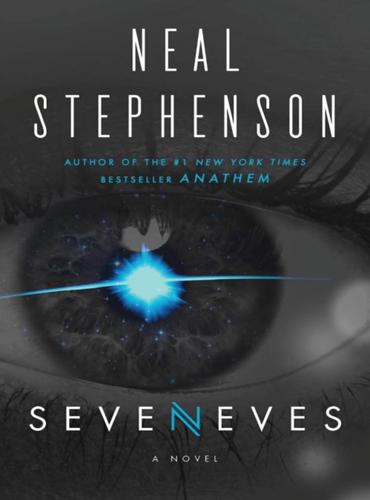
Seveneves
by
Neal Stephenson
Published 19 May 2015
With the hand on the robot arm, Dinah was able to grapple this easily and pull the device out into the light. “Any reason not to just ’biner it onto the X-37’s arm?” she asked. “Can’t think of any.” “What is it you’re doing?” Julia asked. “Deorbiting that piece of space junk before it kills someone.” “That piece of space junk happens to be carrying the earthly remains of a brave man who gave his life in the name of—” Dinah said, “Ivy, you want to take this or should I?” “I’ll do it. You’re busy,” Ivy said. Dinah could hear her twisting around in the pilot’s seat to look at Julia. She spoke as follows: “Julia.
…
She could watch their activities on video feeds if she wanted, but she had other things she needed to be doing. After the micrometeoroid/Luk incident, Dinah had scored a small victory for robotdom by putting her flock to work getting the surviving Luks squared away. Amalthea was attached to the forward end of Izzy, which, because of its orbital direction, was most exposed to impacts from space junk. In effect the asteroid had been put there as a sort of battering ram, protecting everything aft of it from collisions. There was enough space on its aft side that several Luks could nestle there, improving their odds of long-term survival as well as cutting down on cosmic ray exposure. Dinah’s crew of iron-mining robots had been made obsolete, at least for the time being, by her boss’s pivot toward frozen water.
…
Now she had gone silent. She was still out there—Konrad could still pick her up as a white dot on his optical telescope. Since she was merely coasting for thirty-seven days, not firing her engines, there was no way to tell whether the crew was still alive. A perfectly shipshape Ymir and a crumpled wad of space junk would have looked and behaved the same. They drew some hope from the fact that nothing came back from her. Ymir had automatic systems that were supposed to phone home without human intervention. If those had continued to function while communication from humans had ceased, it would suggest that the crew were all dead or incapacitated.

Do You Dream of Terra-Two?
by
Temi Oh
Published 15 Mar 2019
Even with his new, more intuitive, understanding of the games, Jesse would still get stalled for a week on a single level, unable to master the delicate manoeuvres required to steer through a cloud of accelerating space junk, or to rendezvous with another craft. During those times, the task would plague him. His frazzled mind projected planets, darkly visible in the foreground, particles of dust suddenly and momentarily iridescent before a careening asteroid knocked him abruptly back into consciousness. One fine night, by some miracle of dexterity, Jesse managed to skate through every challenge. Though the hull of his ship was fairly dented, it remained unbreached. He dodged debris and space junk and avoided sudden death by decompression. His heart pounding and palms sweating, Jesse’s mind narrowed into a corridor of exhausted focus.
…
And as he did, it began to resolve before him. Jesse had been here before. He had been on this ship a thousand times, looking out at a sky that blazed destruction. During the game, Jesse had piloted his virtual crew through dusty asteroid belts when they were running low on oxygen. He’d navigated his way through space junk and landed in deserts without his ship burning up like a firecracker in the atmosphere. At least – not every time. Jesse saw, again, that his time had come. As adrenaline roared through his veins, he started to unbuckle his seatbelt. ‘I can do it,’ he said, lunging forward, just as he had the night of Ara’s death.

Accessory to War: The Unspoken Alliance Between Astrophysics and the Military
by
Neil Degrasse Tyson
and
Avis Lang
Published 10 Sep 2018
The difference is not inherent in the weapons themselves. One de facto category of space weapon has nothing to do with intentional deployment: space junk. It’s already up there, the inevitable but inadvertent result of smashups, explosions, rocket launches, space-walk maneuvers, the ordinary dumping of trash, and the inevitable demise of assorted spacecraft. From a distance, it looks like a cloud of dandruff ringing our planet, mostly in low Earth orbit, because that’s where most satellites are found. But space junk populates all of nearby space, extending six Earth radii out to the zone of geosynchronous satellites.10 Besides a few notable mementoes of the late 1950s, such as the final stage of the launch rocket for the USSR’s first Sputnik and the entirety of America’s first Vanguard, hundreds of thousands of unguided bits of flotsam and jetsam orbit Earth amid our working satellites.
…
Not until 2013 did the country’s armed forces have their own surveillance satellite, Sapphire, built in Canada and launched in India. This satellite, however, takes no part in warfighting. It serves to guarantee the safety of the world’s, not merely Canada’s, space assets by monitoring every piece of space junk larger than ten centimeters across. Think of it as an eminently peaceable example of the military’s traditional obligation to protect and defend, as well as the opening salvo in Canada’s amplified space capabilities. Beginning in 2014 the Canadian Air Forces Space Cadre has provided Joint Operations Command with 24/7 support, which includes missile warnings, launch notifications, GPS status updates, and detection of any electronic interference directed at satellites.
…
P., 188, 243–44, 245 Royal Academy of Sciences (France), 93 Royal Observatory Greenwich, 89, 93, 94, 98–99 Royal Society of London for the Improvement of Natural Knowledge, 445n r-process (nuclear physics), 403, 532n Rudolf II, 49, 424n Rudolph, Arthur, 262 Rumsfeld, Donald, 11, 248, 393, 395, 416n Rumsfeld Space Commission, 11–12, 21, 323, 393, 395, 493n running down the latitude, 82 Rusk, Dean, 292 Russia American astronauts ferried to ISS by, 27–28, 356–57 annexation of Crimea, 370, 389 ASATs (antisatellite weapons), 259 economy after Soviet Union collapse, 361–62 GLONASS global positioning system, 160, 337–38, 362, 363, 516n inflation in 1990s, 361 joint ventures and foreign support in space, 363, 364, 368, 371 military spending, 353, 519n rocket engine ban by United States, 371–72 rocket engine sales to United States, 363, 364, 371 Roscosmos, 337, 352, 363–64, 370, 372 space spending, 362, 364 strained US–Russia relations, 357, 521n Ukrainian incursions, 389 Western sanctions against, 364, 370, 389 Rutherfurd, Lewis, 98 Sacred Games (Chandra), 54–55 Sagan, Carl, 250, 251–52, 254, 255, 360, 388 Sagdeev, Roald, 360–61 Sahul, 64 Sambrook, Stephen, 134, 452n SAMOS (Satellite and Missile Observation System), 278, 471n sandglasses, 77, 93 Santa Ana sinking, 110 SAO/NASA Astrophysics Data System, 391 Sapphire satellite (Canada), 354 Sarabhai, Vikram, 352 Sarpi, Paolo, 442n Sassoon, Siegfried, 387 satellites debris from destruction of, 3, 32, 235, 258 development by Soviet Union, 262, 264, 268 development by United States, 262, 267–68, 487n, 488–89n disruption of, 259–60 dual-use satellites, 159, 207, 256, 278, 321 growing dependence on, 235, 257, 339–40, 478n number in orbit, 235, 458n as potential targets in space war, 235, 257 see also specific types Saturn astrology and, 50, 52, 56, 79 rings (companions), 21, 52, 103, 110, 165 Saxton, Jim, 412n Schott AG, 132 Schott & Associates Glass Technology Laboratory, 132, 135, 138, 139, 452nn Schott, Otto, 132 Schriever Air Force Base, 16, 337 Schwerin von Krosigk, Lutz, 61–62 Science, The Endless Frontier, 270–71 Scilly Isles, 95 scintillators, 213–14, 216 SCORE communication satellite, 278 Scud missiles, 341 scurvy, 85 Sea Launch partnership, 363 search receivers, 196 security, meanings of, 13–15, 413nn Seeger, Hans, 454n Selenographia (Hevelius), 455n Selin, Ivan, 485n Seller, John, 66, 431n September 11, 2001, attacks Nostradamus “prophecy” and, 53 reaction to, 11, 12–13, 328, 412n Sessions, Jeff, 412n seven, mystical significance of, 166, 460n seventeenth-century wars, nature and frequency of, 108, 443n Shangshu, or The Book of History, 66–67, 431n Sheehan, Michael J., 151, 367, 373, 376–77 Shelby, Richard, 412n Shevardnadze, Eduard, 307 Shovell, Cloudesley, 95 Siddiqi, Asif A., 486–7nn, 489–90nn Sidereus Nuncius (Galileo), 52–53, 141, 455n sighting tubes, 101, 119 Signal Corps (US Army Signal Corps) adaptability after Civil War, 128 casualties, 126, 448–49n in Civil War, 123, 124, 125, 447n, 448–49nn Pearl Harbor attack and, 189, 466–67n radar and, 189, 191 radio waves bounced off Moon surface, 191 Scientific and Study Division, 128 during World War I, 128, 450n silver chloride, 143, 168 Simes, Dimitri, 252 Simon, Scott, 30 Singh, Khushwant, 54 Siracusa, Joseph M., 306 Sirius (Dog Star), 39, 40 situational awareness, 155, 157, 162, 329, 396, 397 Skunk Works (Lockheed Aircraft), 198, 276, 469n Sloan Digital Sky Survey (SDSS), 224–25 Smith, John, 436n Snowden, Edward, 14, 413n Sobel, Dava, 73, 95 Socrates, 46 sodium, spectroscopy of, 145, 146 Sorrows of Empire, The (Johnson), 35 Sotheby’s, 361–62 Soviet Union atomic and nuclear bomb development, 263 Berlin blockade, 266, 303 collapse of, 357–59 intent to dominate the world, 304–5 Luna (Lunik) probes, 211, 271, 473n Mir space station, 359–60, 362, 522n missile defense program, 250, 252 political purges, 266 rocket development, 262, 263–64, 269, 486–87n, 490n satellite development, 262, 264, 268 science education in, 270 Soviet Star Wars (Skif and Kaskad), 359–60, 522n space program in 1980s, 359–61 US–Soviet cooperation in space, 357 Venera probes, 211 vilification by the West, 265 see also Sputnik Soyuz, 357, 363, 370, 372, 389, 521n space control, 157, 396, 530–31nn space debris from asteroid deflection, 255 monitoring by Sapphire satellite, 354 overview of space junk, 237–38 from satellite destruction, 3, 32, 235, 258, 393 “Star Drek” (Maher), 392 United Nations concerns about, 260, 486n space diplomacy, 260–61, 312–13, 531n space economy worldwide, overview, 349–50, 518n Space Foundation charter of, 15 National Space Symposium, 16–20, 24–25, 26, 414n, 415n, 417n Space Foundation Index, 15–16 Space Report: The Authoritative Guide to Global Space Activity, The, 15, 21, 510n, 520n Space Technology and Investment Forum, 414n Strategic Space Symposium, 414n Space Handbook, The (Buchheim), 248 Space Operations: Air Force Doctrine Document, 297, 321, 324, 503n “Space Pearl Harbor,” 12, 393, 411n space power China and, 5, 26, 32–33, 318–19, 372–73 competition and, 324–25 European approach to, 325–30 in first Gulf War, 330–36, 340–44 Five D’s: deception, disruption, denial, degradation, and destruction, 322 in future wars, 348–49 in Iraq War, 344–48 Kennedy’s strategy, 319–20 leadership and, 318, 323–25 nature of, 317–18, 379–80 and space economy, 349–56 see also space superiority space programs of various countries, 32 see also specific countries Space Report: The Authoritative Guide to Global Space Activity, The (Space Foundation), 15, 21 space science, links to military technology, 20–21 Space Security Index, 397 space shuttle Challenger disaster, 357 shrinking workforce, 27 termination of program, 27, 363, 370 viewed as possible ASAT, 258 space superiority, 236–37, 302, 321–22, 324, 366, 396, 479n, 530–31nn see also space power Space Surveillance Network, 238 Space Technology and Investment Forum, 414n space war cyberwar and, 235 Gulf War as first space war, 330–31 preparing plans for, 235–36, 238, 321–22, 478n remote possibility of, 312, 349, 392–96 satellites as potential targets, 235, 257 Spacewatch debate, 251–52 space weapons, 256–60, 286, 297–301, 312–13, 397, 485n Space Weapons Earth Wars, 297–301, 504n space weather, 160–61 SpaceX, 21, 300, 337 Spain Treaty of Saragossa, 88 Treaty of Tordesillas, 88 Twelve Years’ Truce with Netherlands, 104, 107 special theory of relativity, 218, 336 spectacle lenses, 102, 442n spectroscopy, overview and history, 140, 144–48 Spektr-RG orbital X-ray observatory, 364 Spencer, Percy, 189 sphaera of Posidonius, 422n Spinola, Ambrogio, 107 Spitzer, Lyman, 262, 487n Spitzer Space Telescope (NASA), 199, 487n SPOT, 343, 344 Sputnik booster rocket, 32–33, 210, 237, 269, 271 and “freedom of space” issue, 268–69, 301, 505n launch date, 32, 158, 210, 268, 269 radio transmitter, 33, 269 Sputnik 2, 269, 279 Sputnik 3, 271 tracking by Jodrell Bank, 210 spy satellites, 204–7, 228, 342–45, 471n, 517n see also remote-sensing satellites; specific types Square Kilometre Array, 183 Sri Lanka, 32, 64, 69, 430n Stalin, Josef, 263–64, 266, 282, 303 Standard Inscription of Ashurnasirpal, 33–34, 420n “Star Drek” (Maher), 392 Starsem, 363 stars, twinkling of, 152–54, 300 Star Trek (TV series), 175, 241 Star Wars (movie), 241, 249 static (noise), 177, 178 stealth aircraft albedo and, 197 B-2 stealth bombers, 198, 303, 470n control of reflection, 175, 196 development of, 197–98, 469–70n F-117A stealth fighter, 197, 198, 332, 470n, 514n Operation Desert Storm, 7, 197, 332, 514n Operation Iraqi Freedom, 197 stellar nurseries, 199 Stiglitz, Joseph E., 416n Stone, I.
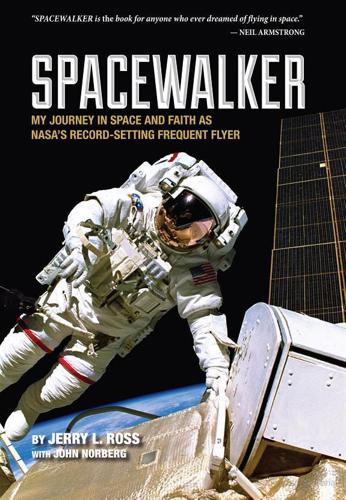
Spacewalker: My Journey in Space and Faith as NASA's Record-Setting Frequent Flyer
by
Jerry Lynn Ross
and
John Norberg
Published 31 Jan 2013
There are a lot of industrial plants in the area, and there was an incredibly bright flare burning at one of the plants that really caught my attention. As we passed on across the central US, over Detroit, and into Canada, I could still look back at Houston and see that flare. We did not see any flying saucers, no aliens, and no UFOs, but I did see several meteorites and pieces of space junk burning up as they entered the Earth’s atmosphere underneath us. On my first mission we had two spacewalks scheduled, but before we got to them we had a lot of other work to complete. Using Atlantis’s computers and control panels in the aft flight deck, Woody and I launched three communications satellites from the payload bay.
…
In less than a minute the orders came from Houston to Steve: “Why don’t you send Jerry and Jay downstairs to get ready for an EVA.” This was going to be my third spacewalk and my first unplanned EVA. I was a little nervous. If we couldn’t fix the $670 million Observatory, we would have to deploy a very large and very expensive piece of space junk. Once Jay and I were outside the air lock, I asked Linda to move the Observatory down and closer to the starboard (right) side of the payload bay. Linda operated the arm to bring the satellite into position. Then I looked for a path so I could move to where the antenna boom was mounted. The satellite’s large propellant tanks were right in front of me, and I knew I had to be very careful not to rupture them or to do any damage to the satellite while moving around.
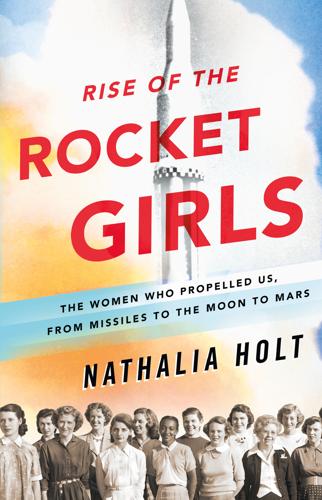
Rise of the Rocket Girls: The Women Who Propelled Us, From Missiles to the Moon to Mars
by
Nathalia Holt
Published 4 Apr 2016
Not only that, but they’d beaten the Soviets. It was their first win in the space race, and the victory was precious to all of them. Mariner would inch toward the sun before sending out its last signal on January 3, 1963. After that, JPL would lose contact with it forever as it became just another piece of space junk spinning around the sun. While Mariner 2 was sending out its farewell signals, the women watched the Rose Parade on New Year’s Day 1963. One of the floats was a giant planet Venus, constructed in yellow flowers with the words “Venus to Pasadena” written on it in red roses. They watched as a replica Mariner spacecraft, just like the one they built, floated above the big ball of flowers.
…
They attached four large solar panels and a crowning antenna before testing all the systems. Watching the designs come together before their eyes was both thrilling and frightening for the computers. They could never be sure if these creations were headed for greatness, would explode into a million pieces, or would simply become floating space junk. On the evening of November 5, Mariner 3 was ready to go at the former Cape Canaveral, now known as Cape Kennedy. It sat atop the Atlas-Agena rockets on the same launchpad from which Ranger 7 had so recently experienced its success. The team in the control room wasn’t superstitious, but just in case, peanuts were again passed out.
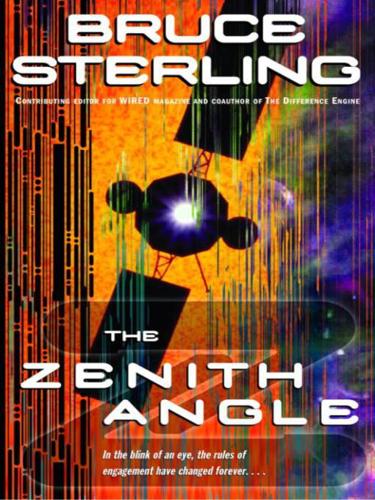
The Zenith Angle
by
Bruce Sterling
Published 27 Apr 2004
Van could handle that question. “That’s BUMPER, your space-junk debris collision program. I looked at BUMPER, too. BUMPER has an unexamined assumption in its design specs. BUMPER assumes that debris cannot intercept a spacecraft from more than ten degrees above or below a plane tangent to the Earth normal.” Wessler scratched the back of his neck. “Of course. Otherwise that debris would fall right into the Earth’s atmosphere and burn up immediately.” “No,” said Van. “Not if the debris were coming off of the spacecraft itself. Not big chunks of space junk, not yet. But a fine haze of debris. Ionized. Ablated.
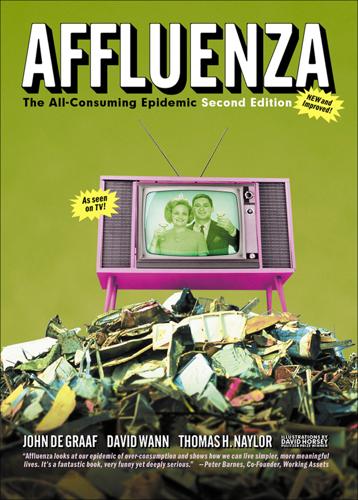
Affluenza: The All-Consuming Epidemic
by
John de Graaf
,
David Wann
,
Thomas H Naylor
and
David Horsey
Published 1 Jan 2001
More than seven million pounds of spaceship pieces are hurtling around the planet at 22,000 miles an hour. At that speed, a piece of space debris the size of a small marble has the kinetic energy of a 400-pound boulder dropped from a hundred feet. To get out beyond the hazards of Earth’s space clutter, future astronauts may spend much of their time dodging bullets of space junk. Meanwhile, back on Earth, space-junk collectors like Jim Bernath of British Columbia anxiously await the descent of more debris, to add to their collections. Bernath already owns chunks of comets and bits of the Canadarm, a device built to retrieve satellites. He’s especially hopeful that a piece of the junked MIR space station will fall somewhere in Canada—possibly right into his own backyard.5 ANALYZING THE AMERICAN DREAM: WHERE CLUTTER COMES FROM America’s 111 million households—the authors’ among them—contain and consume more stuff than all other households throughout history, put together.
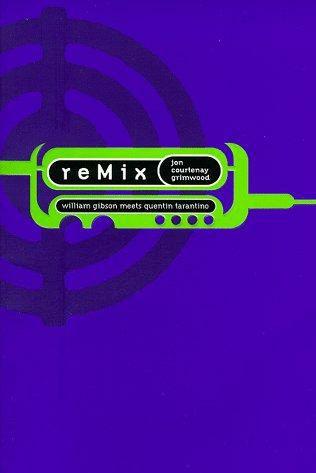
Remix
by
John Courtenay Grimwood
Published 15 Nov 2001
Brother Michael was waiting for her, sitting in a huge steel chair below the altar. Steel pillars rose to a crystal ceiling and the whole dark sky was revealed above his head, so that from where she stood in the Otis doorway LizAlec could see all the way through to eternity. If eternity was what was really out there beyond the dust and the space junk. She left the crystalMeth-fuelled cosmic ramblings to Fixx. “You wanted to see me?” LizAlec demanded, staring at the seated man. No way was she praying with him. She’d decided that before the lift even blasted off from her level. The man didn’t answer. Instead, he just clicked his fingers twice and the lift door shut behind her, vanishing down the spindle with a low hiss.
…
“Sure,” she said glibly, “it’s yours.” The boy nodded and walked over to the nearest flatscreen. Running his fingers over its flickering surface he woke an icon called lasso and watched as a cartoon drone navigated slow circles around a cartoon dustbin, wrapping it in monofilament. “Salvage,” the boy explained. “Space junk. You’d be ‘mazed how much there is out here.” Leon knew, it was his ship. Well, seventeen per cent of it was and the figure was rising. Jude had put up the guarantee, but then that was what mothers were for, and he’d never missed a payment. Didn’t intend to, either. All that other shit was just stuff he’d told the other two.
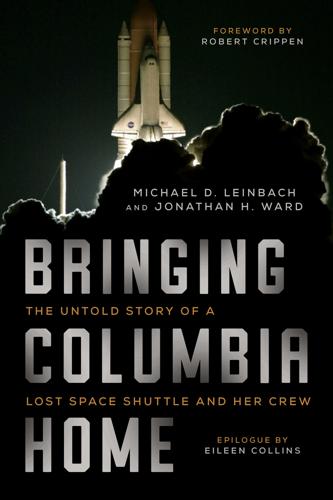
Bringing Columbia Home: The Untold Story of a Lost Space Shuttle and Her Crew
by
Michael Leinbach
and
Jonathan H. Ward
Published 23 Jan 2018
The analysts noticed that another object was in the same orbit as Columbia beginning on the second day of the mission. After refining the radar data, the analysts determined that a slow-moving object, about the size of a laptop computer, gradually drifted away from the shuttle. Its slow motion implied that it was probably not a piece of space junk or a meteor. Further tests showed that the radar properties of the object were a close match for a piece of RCC panel—possibly part of the wing’s leading edge. It appeared to separate from the shuttle after several thruster firings that changed Columbia’s orbital orientation. Whatever it was, the object reentered the Earth’s atmosphere and burned up on January 20, twelve days before the end of Columbia’s mission.
…
Robert Crippen, remarks at the KSC Columbia Memorial Service, February 7, 2003, https://www.youtube.com/watch?v=ubYGeGU8jOo. 35. FEMA, “FEMA Updates Search, Find, and Secure Activities for Columbia Investigation,” news release 3171-13, February 7, 2003. 36. Pat Oden email, February 8, 2003. 37. Interview with Larry Ostarly. 38. Interview with Scott Thurston. 39. “NASA Studies Possibility of Space Junk Role,” Florida Today, February 6, 2003, 2S. 40. Mike Leinbach believes that perhaps the foam strike on the wing displaced an RCC panel on Columbia’s wing by compromising its support structure and pushing it back into the cavity behind the leading edge. From there, it could have eventually broken off due to thermal expansion and contraction as the shuttle moved back and forth between orbital day and night.

Visual Thinking: The Hidden Gifts of People Who Think in Pictures, Patterns, and Abstractions
by
Temple Grandin, Ph.d.
Published 11 Oct 2022
Threading the ropes in loops through the carabiners reminded him of the long strands of DNA connecting the chromosomes. Pure visual connection. It was like the string on a bolo tie or the multiple loops that I embroidered to make daisies in third grade. According to Raffi Khatchadourian, in a New Yorker article titled “The Elusive Peril of Space Junk,” astronauts on a spacewalk were horrified to find that the Hubble Space Telescope’s cylindrical surface had been pockmarked by tiny pieces of debris, the way sand on a highway will pit your truck. Astronaut Drew Feustel said, “A fleck could come from anywhere, any time.” A satellite research project known as RemoveDEBRIS was launched to develop technologies to combat interstellar debris.
…
Cytokine and Anti-Cytokine Interventions.” Autoimmunity Reviews (July 2020): 102567. Jensen, A. R. “Most Adults Know More Than 42,000 Words.” Frontiers, August 16, 2016. Keogh, R., and J. Pearson. “The Blind Mind: No Sensory Visual Imagery in Aphantasia.” Cortex 105 (2018): 53–60. Khatchadourian, R. “The Elusive Peril of Space Junk.” The New Yorker, September 21, 2020. Khatchadourian, R. “The Trash Nebula.” New Yorker, September 28, 2020. Koć-Januchta, M., et al. “Visualizers versus Verbalizers: Effects of Cognitive Style on Learning with Texts and Pictures.” Computers in Human Behavior 68 (2017): 170–79. doi.org/10.1016/j.chb.2016.11.028.
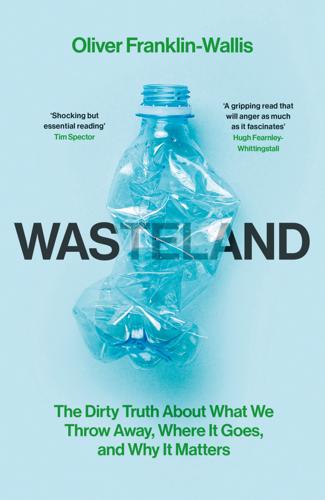
Wasteland: The Dirty Truth About What We Throw Away, Where It Goes, and Why It Matters
by
Oliver Franklin-Wallis
Published 21 Jun 2023
‘Microplastics and synthetic particles ingested by deep-sea amphipods in six of the deepest marine ecosystems on Earth’, Royal Society Open Science 6(3), 2019: DOI: 10.1098/rsos.180667 3 United Nations Environment Programme, From Pollution to Solution: A Global Assessment of Marine Litter and Plastic Pollution, 2021. 4 Plastic Pollution Coalition, ‘New Research Shows The Great Pacific Garbage Patch is 3 Times The Size of France’, 2018: https://www.plasticpollutioncoalition.org/blog/2018/3/23/new-research-shows-the-great-pacific-garbage-patch-is-3-times-the-size-of-france 5 Raffi Khatchadourian, ‘The Elusive Peril Of Space Junk’, New Yorker, 21/09/2020: https://www.newyorker.com/magazine/2020/09/28/the-elusive-peril-of-space-junk 6 S. Kaza, L. Yao, P. Bhada-Tata and F. Van Woerden, ‘What A Waste 2.0: A Global Snapshot of Solid Waste Management to 2050’, The World Bank (2018): DOI: 10.1596/978-1-4648-1329-0 7 Ibid. 8 Sandra Laville and Matthew Taylor, ‘A million bottles a minute: world’s plastic binge “as dangerous as climate change”’, The Guardian, 28/06/2017: https://www.theguardian.com/environment/2017/jun/28/a-million-a-minute-worlds-plastic-bottle-binge-as-dangerous-as-climate-change 9 Tik Root, ‘Cigarette butts are toxic plastic pollution.
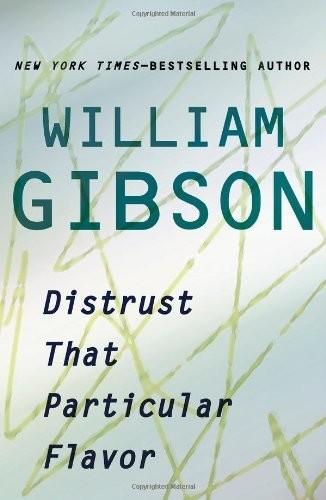
Distrust That Particular Flavor
by
William Gibson
Published 3 Jan 2012
The techno-cultural suppleness that gives us Mobile Girls today is the result of a traumatic and ongoing temporal dislocation that began when the Japanese, emerging in the 1860s from a very long period of deep cultural isolation, sent a posse of bright young noblemen off to England. These young men returned bearing word of an alien technological culture they must have found as marvelous, as disconcerting, as we might find the products of reverse-engineered Roswell space junk. These Modern Boys, as the techno-cult they spawned came popularly to be known, somehow induced the nation of Japan to swallow whole the entirety of the Industrial Revolution. The resulting spasms were violent, painful, and probably inconceivably disorienting. The Japanese bought the entire train set: clock-time, steam railroads, electric telegraphy, western medical advances.
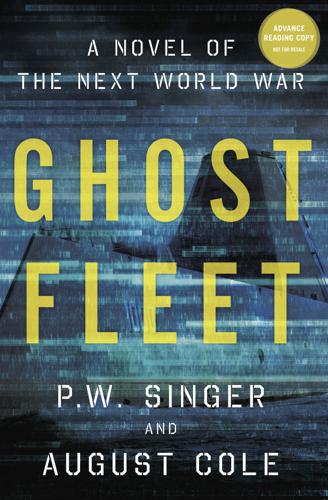
Ghost Fleet: A Novel of the Next World War
by
P. W. Singer
and
August Cole
Published 28 Jun 2015
Chang wanted to shout. All the targets have been serviced! The only real threat they had faced came from a U.S. Air Force jet — an F-15, Huan said later, flying at its maximum altitude — that had fired an antisatellite missile at the station. The Tiangong’s laser-defense system turned the missile into more space junk and would have lased the plane if it hadn’t had some kind of high-altitude mechanical failure first. The worst part about that action was that it was all automated. Chang wanted his son to think he was a hero, but the onboard systems had handled the targeting while Chang slept. He ate another mooncake and gazed longingly down at the blue Pacific.
…
This part of space is going to light up as the American ASAT missiles start knocking down the Chinese and Russian birds. Then they’ll try to launch their satellites, and the Directorate will do the same. With no one commanding space, each side will just knock the other’s satellites down as fast as they’re launched. Pretty soon any orbit above the Pacific is going to be one big cloud of space junk.” “Makes you wish you worked for someone who had the foresight to invest in the rocket-fuel business,” said Cavendish, starting to calculate a new set of gains. “To the Tallyho, then! Mr. Tick, are you up for it?” “I’m feeling no pain, sir,” said Tick. The commando’s forehead was swollen and his eyes were bloodshot.

50 Future Ideas You Really Need to Know
by
Richard Watson
Published 5 Nov 2013
There’s no air in space either, so the solar radiation is not being filtered by atmospheric gases. And the system produces no pollution. Putting collecting dishes into space would obviously be a mammoth task, but we have done it already on a very small scale. There’s also the issue of maintenance. Space is not a benign environment, and equipment will get damaged from rocks and manmade space junk, so how will we repair it? Robots permanently stationed in space probably. Likewise how can we beam the energy back to Earth without losing energy in transmission? There’s the difficulty of keeping the space-based energy beams locked onto the rectifying antennas (or rectennas) connected to the receiving stations back on Earth.
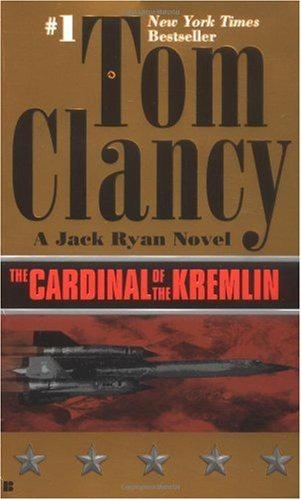
The Cardinal of the Kremlin
by
Tom Clancy
Published 2 Jan 1988
The camera system was put in the MTI-mode. A computer that registered all the energy sources the telescope found began to search only for targets that were moving. The technicians on the screens watched as the Moving-Target Indicator rapidly eliminated the stars and began to find a few low-altitude satellites and fragments of orbiting space junk. The camera system was sensitive enough to detect the heat of a human body at a range of one thousand miles, and soon they had their choice of targets. The camera locked on them one by one and made its photographic images in digital code on computer tape. Though mainly a practice drill, this data would automatically be forwarded to NORAD, where it would update the register of information of orbiting objects.
…
The solar cells arrayed on the body of the satellite-which were designed to absorb light energy-appeared to be burned off entirely. On closer inspection, the entire satellite body was distorted from the energy that had blasted it. Pokryshkin nodded, but his expression hadn't changed. "We were supposed to have chopped a hole right through it. If we can do that, it would look as though a piece of orbiting space junk had impacted the satellite. That's the kind of energy concentration we were looking for." "But you can now destroy any American satellite you wish!" "Bright Star wasn't built to destroy satellites, Colonel. We can already do that easily enough." And Bondarenko got the message. Bright Star had, in fact, been built for that specific purpose, but the power breakthrough that had justified the funding for the installation exceeded expectations by a factor of four, and Pokryshkin wanted to make two leaps at once, to demonstrate an antisatellite capability and a system that could be adapted to ballistic-missile defense.

Chasing New Horizons: Inside the Epic First Mission to Pluto
by
Alan Stern
and
David Grinspoon
Published 2 May 2018
The second big setback came just months later, in August 1993, when NASA’s Mars Observer spacecraft blew up three days before it was to fire its engine to go into orbit around the red planet. This orbiter had been conceived as NASA’s triumphant return to Mars, ending a long hiatus since the Vikings, which were launched in 1975, but now it had become space junk orbiting the Sun. Goldin’s response to the Mars Observer failure was typically bold: he started an entirely new program of multiple spacecraft to be sent to Mars, replacing the lost science and doing much more, with a whole series of missions to be launched over many years. He would use this new Mars program to implement his “faster, better, cheaper” philosophy, investing less in testing and redundancy, and accepting more risk as a trade-off against more-frequent missions.
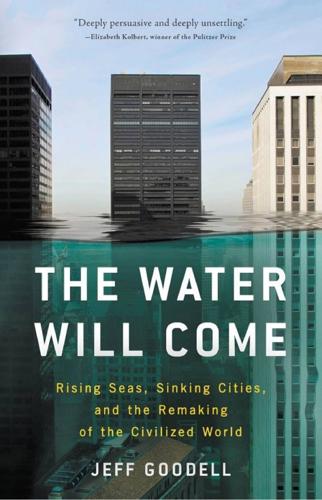
The Water Will Come: Rising Seas, Sinking Cities, and the Remaking of the Civilized World
by
Jeff Goodell
Published 23 Oct 2017
In 2008, when a storm surge flooded the base and destroyed all the freshwater supplies on the island, the military responded with expensive desalination machines and heavy-duty barriers made of a fortified granite commonly called riprap. The Pentagon is apparently feeling confident enough about these fortifications to invest $1 billion in a new radar installation on the atoll designed to help satellites and astronauts avoid colliding with space junk as they orbit the Earth. “It is a different world out on the base,” one Marshall Islander who works at the test site told me. “It is a place where you feel safe.” Outside the base, there are only sand and crumbling seawalls and water as far as you can see. The questions that view provokes in the Marshallese are elemental: How long can I stay?

Beyond: Our Future in Space
by
Chris Impey
Published 12 Apr 2015
A climber on a space-elevator cable would move more slowly on each successive part of the cable onto which it moved. This acts as a deflection or a sideways drag on the cable. The effect works in the opposite direction for a descent of the cable. In practice, this Coriolis force limits the speed at which a cable can be ascended. Finally, there are risks from meteorites and from the 6,000 tons of space junk orbiting the Earth in its potential path, plus vulnerability of such a large target to a terrorist attack. One elevator isn’t very efficient. There would have to be at least one for going up and one for going down. To avoid nasty oscillations, the speed might have to be kept to around 100 mph, making the journey take several weeks.
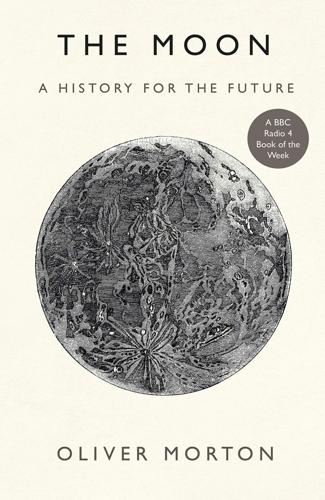
The Moon: A History for the Future
by
Oliver Morton
Published 1 May 2019
There is a story that a LM fuel tank unwisely tapped with a ball-point pen during outdoor testing resulted in that pen being embedded in a fence post some way away, along with some of the unwise tapping finger. During development, the fuel and oxidizer lines will not stop leaking. When Grumman ships the first purportedly flight-ready LM down to Cape Kennedy, it is rejected as not fit for the launch pad let alone for space: “Junk. Garbage.” Trying to solve the problems makes the third LM so late to the Cape that there is not enough time to ready it for its scheduled flight.7 What was expected to be a routine vacuum test for the fifth LM goes catastrophically wrong when one of the windows explodes. The windows are crucial.
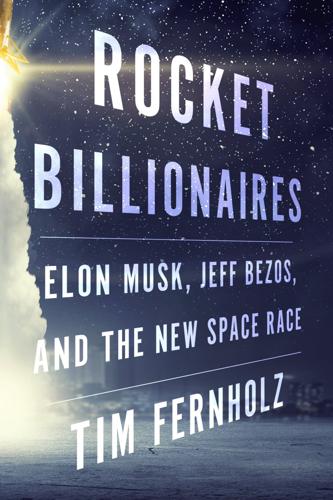
Rocket Billionaires: Elon Musk, Jeff Bezos, and the New Space Race
by
Tim Fernholz
Published 20 Mar 2018
“You have goals, and then you have engineering reality,” Kathy Lueders, the respected NASA manager in charge of the Commercial Crew program, told me. The biggest problem was micrometeoroids and orbital debris from old spacecraft. When the shuttle maneuvered in space, it always flew backward—engine first—to protect the crew; a minuscule piece of space junk impacting at orbital velocity could threaten even a well-protected spacecraft. To make that one-in-a-thousand standard, Lueders told me, “you would probably have to have a spacecraft that had so much tile on it that you would never get it off the ground.” The Constellation program was able to reach a loss-of-crew metric of one in 270, and even that was “really, really tough.”
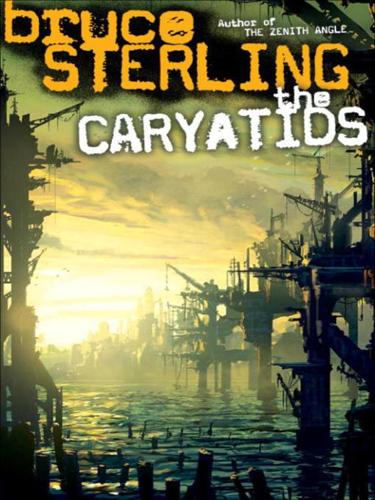
The Caryatids
by
Bruce Sterling
Published 24 Feb 2009
But—some global pundit is absolutely sure to invade that facility, even if it’s just to float around in free fall making snarky comments about the bad industrial design.” “I would go up there,” said Lionel. “I love orbit.” “Oh, I’m definitely going up there, if we somehow survive down here. I’m going to retrieve the body of my dear correspondent, Yelisaveta Mihajlovic. I wouldn’t dream of having that lady jettisoned into outer space … I don’t care how much space junk there is up there already; I swear she won’t become part of it.” Sonja sat heavily on the comfortless floor of the desert. It had never occurred to Sonja that anyone would go to fetch her mother’s body down to Earth. That concept had not crossed her mind for one instant. She had been blind to that idea.
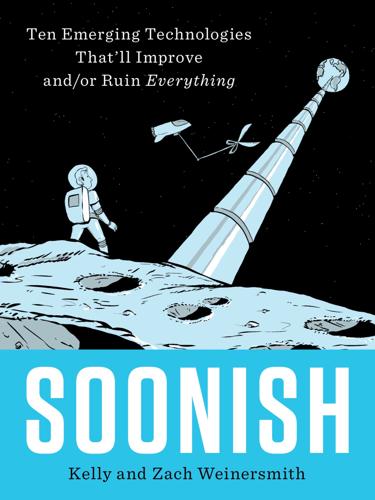
Soonish: Ten Emerging Technologies That'll Improve And/or Ruin Everything
by
Kelly Weinersmith
and
Zach Weinersmith
Published 16 Oct 2017
If the rope is weak but light, it’ll snap the first time it encounters rough conditions, like the high atmospheric winds of Earth. Supposing you can build the cable, the last part is your base station down on Earth. Most proposals call for a moveable sea platform. This is because a moveable platform can maneuver away from bad weather and can adjust the position of the cable in order to avoid space junk higher up. Also, out at sea there is no law. Well, okay, there’s some law. In fact, it’s called the Law of the Sea. But none of it pertains to cables going to space. The laws that’ll govern a space elevator are actually pretty important. It was our sense that most scientists who work on this stuff would like the space elevator, if it’s ever built, to be something that no single nation controls.
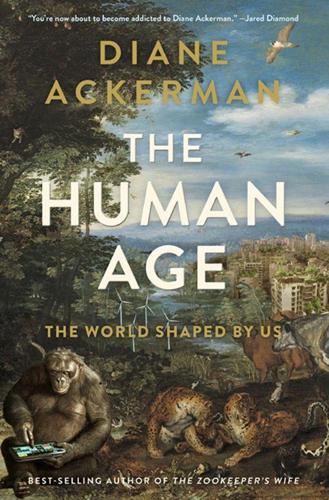
The Human Age: The World Shaped by Us
by
Diane Ackerman
Published 9 Sep 2014
We already harness its rays to power our whims, a feat the gods of ancient mythology would envy. Like supreme beings, we now are present everywhere and in everything. We’ve colonized or left our fingerprints on every inch of the planet, from the ocean sediment to the exosphere, the outermost fringe of atmosphere where molecules escape into space, junk careens, and satellites orbit. Nearly all of the wonders we identify with modern life emerged in just the past two centuries, and over the past couple of decades, like a giant boulder racing ahead of a landslide, the human adventure has accelerated at an especially mind-bending pace. Every day, we’re more at the helm, navigating from outer space to the inner terraces of body and brain.

Bit Rot
by
Douglas Coupland
Published 4 Oct 2016
It enforces confrontation between people who come to the country to do nothing, and those locals who now have nothing to do—which has to be galling. But remember, Greece is just now reaching a place where we’re all going to be sooner or later, a world of massive labour obsolescence where unless you actually know how to do something useful, you’ll become one more piece of middle-class space junk. Don’t forget, while people in the West see the erosion of the middle class as downward mobility, for most of the world, getting online with Android devices to comparison shop for Martha Stewart towels is proof positive they’re on the way up. It’s just that everyone on Earth is reaching a new middle, and we’re still unclear where that middle will be and what it will look and feel like.
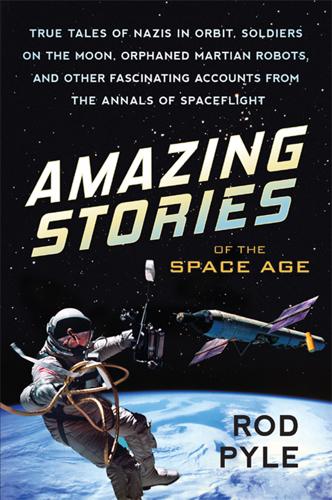
Amazing Stories of the Space Age
by
Rod Pyle
Published 21 Dec 2016
After the Challenger incident, the joints between the SRB segments were redesigned to add another O-ring, and also had a rim-capture feature—basically, rather than allowing the joint to bend open if the booster flexed, it would tighten. This is how it should have been designed in the first place. And there were dangers while in orbit as well. Low Earth orbit, where the shuttle operated, is filled with space junk. Debris from exploded satellites, spent rocket boosters, meteorites, and dozens of other sources, orbit Earth at the same altitudes as the shuttle did and the International Space Station does today. And the numbers are frightening: over 500,000 pieces of space debris are tracked by the air force, and it's estimated that over 170 million bits smaller than a half inch are roaming Earth orbit.8 And it doesn't take much to damage a spacecraft--a piece of detritus the size of a BB carries the destructive punch of a bowling ball traveling at 60 mph.
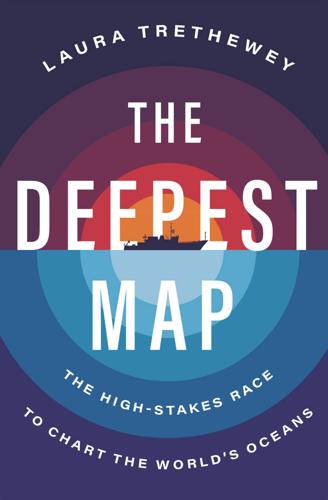
The Deepest Map
by
Laura Trethewey
Published 15 May 2023
He piloted the submersible over to investigate, and his lights illuminated what looked like a cracked oil drum. Someone had been here before, or at least his trash had. Victor wrinkled his nose in disgust, like a hiker who finds his mountain peak sullied by discarded candy wrappers and beer cans. Here is yet another reason we’re drawn to outer space: there are no humans there. Apart from the space junk orbiting Earth, the universe is devoid of other people and all their baggage (and garbage). We can imagine entire untouched extraterrestrial landscapes. The ocean, on the other hand, has long suffered as humanity’s dumping ground. Victor insisted that none of that—the limited outlook, the unimpressive seafloor, the trash—had dampened his enthusiasm for reaching the deepest place in the Atlantic.
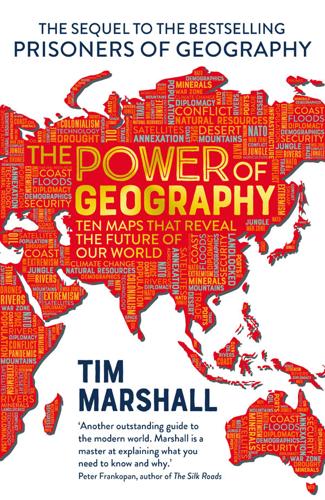
The Power of Geography: Ten Maps That Reveal the Future of Our World
by
Tim Marshall
Published 14 Oct 2021
Conflict in Earth Space creates another problem: a huge amount of debris which would hurtle around in orbit, smashing into the satellite infrastructure of all countries and devastating the global economy. This is something that is already a risk given that there are currently 3,000 dead satellites and 34,000 pieces of space junk at least 10 centimetres in size, and many smaller, orbiting the planet. Some countries are trying to address the problem. If you’ve been to Japan you will have noticed the absence of something – litter. Japan’s SKY Perfect Corporation and the Japanese government have been working on a satellite to remove space debris with lasers that will push bits of debris into the Earth’s atmosphere, where they will burn up.
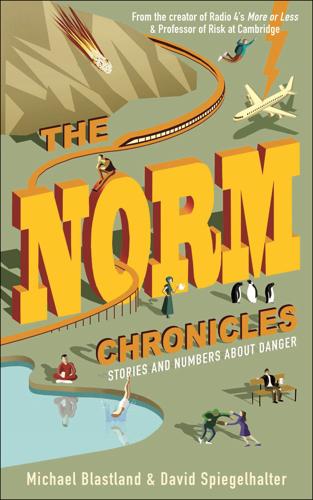
The Norm Chronicles
by
Michael Blastland
Published 14 Oct 2013
A. 190 Minimax regret 56 Minor Planet Center 109, 218 Mitchell and Webb 42 MMR vaccine 68 mobile phones 208 money 268–75 moral panic 39 Morphine 97 mortality at work 197 drowning 55 external causes 15 falls from ladders 9 from asbestos 201 heart disease 9 illegal drugs 103 in childbirth 123 infant 23 maternal 123 maternal in Vienna 125 murder 36 news stories 50 rail international 164 risk and rate 257 roads 168 roads international 169 statistics 4 strangulation 60 mountaineering 176 murder in London 240 risk 35–7 246 N Nanny state 60 nanotechnology 111 narrative see stories NASA, satellite 216 National Lottery as gambling 134 buying all tickets 130 coincidence 77 distribution of numbers 154 winning £100,000 137 National Risk Register 115 National Transportation Safety Board 172 natural hazards 115 natural/unnatural risk 29 Near Earth Object (NEO) 217 New York State hospitals 257 NICE 115 192 Nightingale, Florence 254 nothing/non-events 40–51 Nun, Singing 102 Nutt, David 104 O Oettinger, Gunther 212 old age 271 care costs 274 examples 278 quality of life 283 One Million Random Digits 154 Opium 97 optimism bias 92 over-diagnosis, from screening 263 overweight 190 P parachutes 177 Pascal, Blaise 133, 267 penguins 108 phobia 270 Plane Crash Info 171 plane crashes causes 172 general aviation 173 when occur 172 planning fallacy 92 Plath, Sylvia 121 playground safety 60 poisson distribution 240 possible futures metaphor 290 poverty different households 273 pensioners 272 pregnancy chances 86 teenage 89 with contraception 88 probability and consequence 54, 83, 115, 231, 289 and personal experience 85, 270 and randomness 155 as reasonable betting odds 288 does not exist 5, 288 meaning 10, 287 of dying first 188 prostate cancer 264 Prostate Specific Antigen test (PSA) 264 Public Information films 84 Puerperal fever 124 quantum mechanics 155 Q Quetelet, Adolphe 142, 153, 254 R radiation 204–12 radithor 207 Radon 207 RAF Bomber Command 17 Rail Safety Standards Board 164 Reichelt, Franz 177 relative risk 14, 44 resilience 62 reporting bias 50 retirement 271 rickets 62 risk absolute 14, 44 acute vs chronic 183 aversion 60, 61 and benefit 127 changing perception of 161 communication 117 compensation 192 does not exist independently 286 dread 206 homeostasis 167 images (or pictures) of 83, 171 involuntary 206 perception driven by values 111 perception in sports 180 relative 14, 44 tolerable 202 unacceptable 202 road accidents, children 56 roads 165–70 Roulette 135 Russian Roulette 17, 18 S salience 35, 49 satellites, coming to earth 222 sausages, risk 14 school trips 62 screening 260–67 scuba-diving 178 security airport 262 lie detectors 261 selective samples 85 Semmelweis, Ignaz 124 seriality 76 sex 82–93 sexually transmitted infection (STI) 86 Shipman, Harold 102, 239 Sievert 208 skiing 2 sky-dive 284 risk 144 Slovic, Paul 49, 127, 208, 237 smallpox 66 social control 101 social norms 99 societal concerns 202 space 213–24 space-junk 222 spike, in steering wheel 167 sports, accidents 179 Standardised Hospital-level Mortality Indicator (SHMI) 258 statins 47 still-births 25 stories 4, 65, 266, 195 and coincidence 81 definition of 6 detail in 80, 238 contrasted to non-events 48 in scenario planning 227 crime in the media 236 and truth 239 and patterns 243 medical narrative 251, 261 see also anecdote strangulation, child risk 60 sudden infant deaths 26 Surfers Against Sewage 180 surgery 247–59 Swine flu 71 synchronicity 77 syphilis, rates 83, 90 T tea, as drug 95 teenage pregnancy 89 terrorism 2 lie detectors 261 Thimerosal 71 Thompson, Hunter S. 98, 101, 180 tolerability of risk framework 201 TORINO scale, for asteroid risk 220 total fertility rate 88 trains 160–65 transport 158 accidents 55 trepanation 251 Trier, Lars von 216 trust 167 Tungaska event 216 Tversky, Amos 49 U uncertainty 157, 224, 260, 264 aleatory 151 epistemic 151 unemployment 225–33 V vaccination 63–71 HPV 67 smallpox 67 Value of a Statistical Life (VOSL) 18, 165 variation around average 143 vehicles, number of 168 victim of violent crime, rates 244 Victoria, Queen 121 Vietnam, lottery 131 violence 31–9 crime 244 on railways 162 volcano, Iceland 117 W Wilde, Oscar 96 Willis, Bruce 219 wing-suit 176 Woolf, Virginia 48 World Health Organisation 68, 169, 253 World War II 17 * The story of Anna Bagenholm comes from various sources, including The Lancet1 and Atul Gawande, in his book Better.2 † The usual phrase here is that Anna beat or defied the odds.

Apollo 8: The Thrilling Story of the First Mission to the Moon
by
Jeffrey Kluger
Published 15 May 2017
Soon enough they would be able to do that; once the ship was headed in one direction, physics dictated that it would continue moving in that direction no matter which way its nose was pointed. For the moment, though, the more important issue was that the Saturn V’s third stage was still hanging off the back of their service module. The rocket’s final stage had done its job well, but now it was space junk and it had to go. The third stage was connected to the spacecraft by a ring of explosive bolts. The separation maneuver called for the crew to detonate the bolts, then pulse their thrusters to add a few extra feet per second to their speed. That would open a gap between the spacecraft and the third stage.

The Coming Wave: Technology, Power, and the Twenty-First Century's Greatest Dilemma
by
Mustafa Suleyman
Published 4 Sep 2023
Quite simply, any technology is capable of going wrong, often in ways that directly contradict its original purpose. Think of the way that prescription opioids have created dependence, or how the overuse of antibiotics renders them less effective, or how the proliferation of satellites and debris known as “space junk” imperils spaceflight. As technology proliferates, more people can use it, adapt it, shape it however they like, in chains of causality beyond any individual’s comprehension. As the power of our tools grows exponentially and as access to them rapidly increases, so do the potential harms, an unfolding labyrinth of consequences that no one can fully predict or forestall.
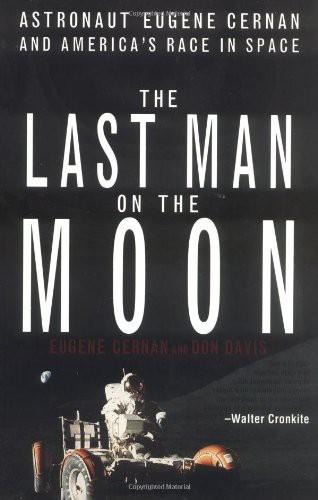
The Last Man on the Moon: Astronaut Eugene Cernan and America's Race in Space
by
Eugene Cernan
and
Donald A. Davis
Published 1 Jan 1998
We had found the elusive Blob in record time, completing the first true assignment of our mission, and were in perfect position, 15 miles below and only 126 miles away. We carefully closed the gap and soon were able to see the flashing strobe and some bright blinks from an unknown source. Nothing was supposed to be doing that. Something was wrong. We maneuvered through a cloud of about a dozen small pieces of space junk that had once been part of the Atlas launch package and had stayed in orbit, flying in peculiar formation with the Blob through the dark sky. Several newspapers ran stories that called the debris “Mysterious UFOs,” and for years thereafter, I would be questioned periodically about my “confirmed” contact with unidentified flying objects and mysterious flashing lights in outer space.
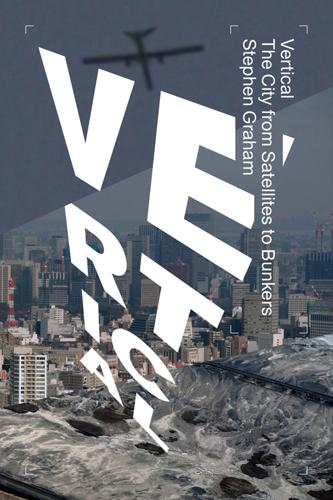
Vertical: The City From Satellites to Bunkers
by
Stephen Graham
Published 8 Nov 2016
– The UK Government’s Satellites Application Catapult There comes a point, as one ascends into the sky from the earth’s surface – and the largely upright human experience of living on it – when the conventions that surround the human experience of the vertical dimension must inevitably break down. At the margins of the earth’s atmosphere and on the threshold of the vast realms of space we enter a world of orbits. At this point we start to encounter the crucial but neglected manufactured environment of satellites and space junk. ‘Verticality pushed to its extreme becomes orbital’, multimedia artist Dario Solman reflects. At such a point ‘the difference between vertical and horizontal ceases to exist’. Such a development brings with it profound and unsettling philosophical challenges for a species that evolved to live upright on terra firma.
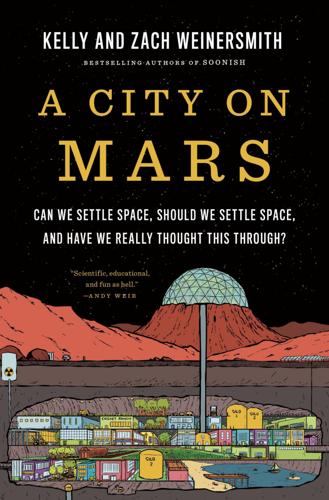
A City on Mars: Can We Settle Space, Should We Settle Space, and Have We Really Thought This Through?
by
Kelly Weinersmith
and
Zach Weinersmith
Published 6 Nov 2023
Stuff You Put into Space Making things even weirder, the current interpretation is that nations do retain sovereignty over stuff they put into space. Neil Armstrong’s poo bags? Those are Uncle Sam’s. But not everything Uncle Sam owns is quite so glamorous—in addition to the literal crap, there’s, well, crap. What’s sometimes called space junk. Broken bits of satellites from weapons tests, that one dead nuclear reactor, and oh yeah, the millions of tiny needles placed into orbit by something called Project West Ford. Regardless of which individuals send objects to space, states are responsible for them and retain ownership. Does that mean an individual can own things in space?
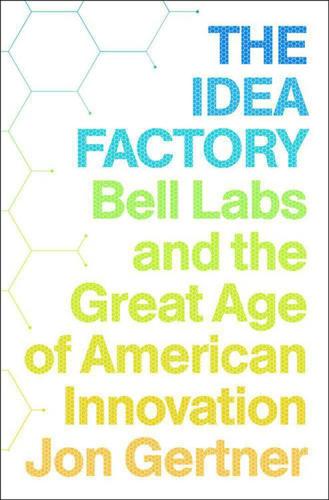
The Idea Factory: Bell Labs and the Great Age of American Innovation
by
Jon Gertner
Published 15 Mar 2012
Not far away is a bronze bust of Claude Shannon, rubbing his chin and looking slightly amused. According to the U.S. Space Objects Registry, as of late 2010, Telstar—the first active satellite—is no longer functional. Yet it still orbits the earth. An exquisite machine requiring a year of nonstop work by hundreds of engineers, it is now a rotating piece of space junk. BELL LABS’ most durable contributions were not things that could be touched or seen. Many of the ideas and innovations that came out of the Labs have been subsumed into a global electronic network far larger and more wondrous than existed when Shannon and Pierce agreed, in the late 1940s, that the Bell System was the most complex machine ever created.

SuperBetter: The Power of Living Gamefully
by
Jane McGonigal
Published 14 Sep 2015
Phillip’s cancer was advanced, and he had been given a prognosis of just two to three years. “When I was diagnosed, I had no idea what multiple myeloma was. My doctor explained that it wasn’t something that could be treated with an operation, because it was in my bones, and not a body part. I was shocked. At my age, getting cancer seemed as likely as getting struck by space junk in my kitchen.” Over the next six years, Phillip underwent many rounds of chemotherapy, which he describes as “lonely, challenging, and exhausting.” He hit his lowest point three years into treatment, when he developed glaucoma, from the side effects of one of his medications, and nearly went blind.
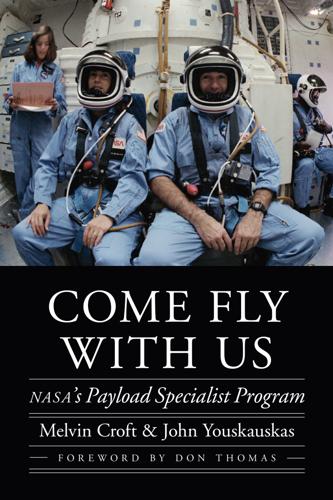
Come Fly With Us: NASA's Payload Specialist Program
by
Melvin Croft
,
John Youskauskas
and
Don Thomas
Published 1 Feb 2019
Thus, the payload crew was more than willing to give up their leisure time to work longer hours on the experiments to ensure they came off as planned. Messerschmid felt that the pressure to do the experiments correctly was far greater than the worry of a life-ending accident occurring. Challenger might be struck by a stray meteroid or errant piece of space junk, causing it to depressurize, inviting the vacuum of space into the bodies of the crew, and sending them into paralysis and convulsions within seconds. Their bodies would swell, and their hearts would stop beating shortly thereafter. Their blood pressure would drop to zero, blood would cease to flow, gases and water vapor would spurt out of their mouths and noses, and their bodies would cool slowly.
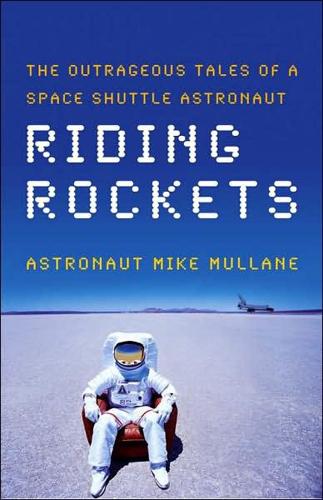
Riding Rockets: The Outrageous Tales of a Space Shuttle Astronaut
by
Mike Mullane
Published 24 Jan 2006
The tolerances were exceedingly tight and I finessed the controls with the deliberation of a soldier probing the dirt for a booby trap. The payload, like all satellites, was as delicately constructed as fine crystal. Any mistake that caused a satellite-to-Atlantisimpact could damage a critical component and turn the object into a billion-dollar piece of space junk and win me an open-ended assignment to Thule, Greenland, where I would get to hone new skills as a urinal scrubber. An impact could also foul the payload bay-door closing system, a mistake that could kill us. Needless to say, the other members of the crew were as focused as I was. All went well.
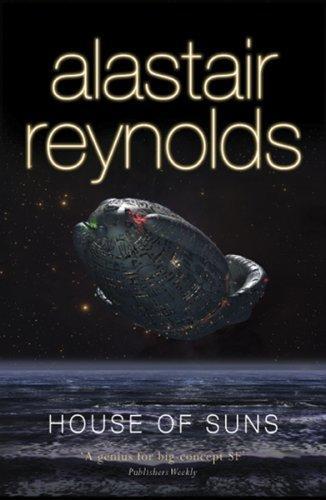
House of Suns
by
Alastair Reynolds
Published 16 Apr 2008
Because he played no part in human affairs, humans eventually forgot about him. There were stories about a thread of ghostly transmissions webbing the Oort, but no one took them any more seriously than a million other myths. When explorers stumbled on one of his elements, they normally assumed it was a piece of space junk from the dawn of the expansion. He sacrificed it anyway. He was incapable of being hurt, or even inconvenienced, by any imaginable human agency. Even the growing power of the Lines caused him no qualms. But the Sun might be a problem. In the decelerated frame of his consciousness, the end of its main sequence lifetime lay only a few thousand subjective years away.

The uplift war
by
David Brin
Published 1 Jun 1987
Ahead of him, about twenty feet away, dawn’s light showed the edge of a steep dropoff. The sound of rushing water rose from far below. Uh, he thought in bemused wonder at his near demise. Another few meters and I wouldn’t’ve been so thirsty right now. With the rising sun the mountainside across the valley became clearer, revealing smoky, scorched trails where larger pieces of space-junk had come down. So much for old Proconsul, Fiben thought. Seven thousand years of loyal service to half a hundred big-time Galactic races, only to be splattered all over a minor planet by one Fiben Bolger, client of wolflings, semi-skilled militia pilot. What an undignified end for a gallant old warrior.